
SUCCESSION PLANNING FOR BUSINESS OWNER CLIENTS SERVING CALIFORNIA’S ANNUITY, LIFE AND HEALTH INSURANCE PROFESSIONALS / JANUARY 2023 Get Ready for • 5 Must Have Marketing Campaigns • Selling Medicare via Social Media • 2023 Compliance Responsibilities
Thank You!
All of the California Broker team members wish our readers success in 2023! We are here to serve our MISSION: to help life and health professionals to access information they can use to enhance the work they do as client advocates.
Our 2023 wish is for our readers to also join our eNewsletter. Please sign up online, and visit our website for additional valuable information.

2023 AND CALIFORNIA BROKER
The new year will bring enhanced digital media designed to impact more life and health insurance professionals in more ways. With digital media we can interact through new connections all in an effort to enhance the communication process to bring you current and reliable articles and news.
We remain committed to deliver our magazine to our 25,000 life and health professionals every month of the year. We continue to work nonstop to produce the e-news Insurance Insider with just the right mix of industry news
and current articles sent to over 8,000 e-subscribers each week.
Thank you to our readers, authors, advertisers and our Cal Broker team members, Linda, Randy, Devon and Zulma. We are pleased to continue the Cal Broker 42 year tradition of excellence as the number one media company for California life and health professionals.
Phil Calhoun, publisher
Blessings, Phil, Linda, Randy, Devon, Zulma
Health plan options that fit your small business clients.































































































































































































































With Covered California for Small Business, we help tailor health plan options so employers and employees can get the coverage they want at a price that fits their budget. Our flexible coverage options work with businesses as they grow to offer coverage that will adapt to their needs as well as care for and retain quality employees.

Insurance companies vary by region. CoveredCA.com/ForSmallBusiness | 844.332.8384
TABLE of CONTENTS
SERVING CALIFORNIA’S ANNUITY, LIFE AND HEALTH INSURANCE PROFESSIONALS
12
2023 MARKETING
The 5 Must-Have Marketing Campaigns Your Insurance Business Needs in 2023
BY JEN DEVORE RICHTER
To make marketing simpler, here are the 5 Must-Have Marketing Campaigns Your Insurance Business Needs in 2023:
14
MEDICARE
Sponsored by AGA
BY SHAUNA HALTOM
Change the Way You Sell Medicare with Social Media Branding Big opportunity! How to leverage social media branding to boost exposure and get more Medicare leads and referrals 16
6 Common Mistakes Insurance Brokers Should Fix for
BY TOM AVERY
2023
Before you leave 2022 behind, it’s important to take time to reflect on what you learned to prepare for success in the new year. How successful Q4 2023 is will depend on your work in the three other quarters leading up to open enrollment.
18
INSURTECH SURVEY
2023 Insurance Trends: U.S. versus the World
3 Key U.S. consumer trends revealed by Remark Global Survey
BY JAMES MACDONALD
The U.S. has a well-established insurance market which blends traditional agentsold approaches, direct mail, phone and online marketing strategies. But
Cal Broker’s commitment is to be the leading source of news and information for California brokers and agents operating in the health, life, and annuity industry. We are committed to connecting Life and Health insurance professionals to valuable resources and solutions they can provide to their insurance clients.
what’s the picture for 2023? And why are American consumers increasingly utilizing online services and leveraging their data more than ever before?
22
DEI
Becoming a “Culturally Competent Benefit Champion” Heightened awareness needed in 2023
BY WAYNE GUZMAN
The purpose of this article is to be a primer and provide guidance to those who desire to learn and become “Culturally Competent Benefit Champions.” This should be a goal for 2023 for us all.
26 FINANCE Tax Planning Fundamentals for Small Business Owners
By John Hassett
With few exceptions, letting the year end without reviewing your tax situation can often result in missed opportunities to save money.
28
COMPLIANCE
Sponsored by Word & Brown Annual 2023 Employer Compliance Responsibilities
Significant non-compliance penalties are no joke!
BY PAUL ROBERTS
An overlooked compliance item can result in significant non-compliance penalties in the federal ACA and COBRA spaces.
30
GENERATIONAL LEADERSHIP: Part Two of Two NAHU Leadership Perspectives Shift to Embrace the Generations
BY DAWN MCFARLAND
Continuing the conversation with favorite mentors Bruce Benton, past NAHU and CAHU and president and Pat Griffey, past NAHU president, with commentary by Joe Navarro
34
InsurTechArtificial Intelligence: Boogeyman or Butler?
An Insurance Agent’s Look into the Future of AI and AutomationBy Joshua Schneeloch My best advice to you as you delve into the world of AI is to avoid becoming tech-centric, or productoriented, but rather be consumercentric.
4 | CALIFORNIA BROKER JANUARY 2023 CalBrokerMag.com
2023 JANUARY
36
TRAVEL MEDICAL INSURANCE
Travel medical insurance: why more customers need it than you may think in 2023
BY DON VAN SCYOC
After a tumultuous several years, it’s great to be able to say that travel is back! As your customers are making itineraries and starting to pack their bags, it’s important to discuss if they’ve thought about their health insurance and if they will have adequate coverage overseas.

38
BOOK REVIEW
“The War on Small Business” by Carol Roth
How government’s Covid-19 restrictions on small businesses propped up Wall Street’s consolidation of power and wealth
BY PHIL CALHOUN
40
Selling the Future
Your Agency’s Potential When You Sell
BY HIREN PARMAR
Agency owners that are contemplating an exit need to have their plan in place if an opportunity presents itself.
42
PLANNING RESOURCES
Advance Planning Opportunity Resources for Business Owner Clients
BY PHIL CALHOUN
New for 2023: A series of news and articles will be focused on key small business owner trends.
44 SMALL GROUP
Small Businesses are California’s Economic Engine Opportunity for brokers continues to grow Excerpted from the State Assembly website: ajed.assembly.ca.gov/reports
PUBLISHER
HealtH Broker PuBlisHing, llC publisher@calbrokermag.com
EDITOR Linda Hubbard Lalande editor@calbrokermag.com linda@calbrokermag.com
ART DIRECTOR Randy Dunbar Randy@calbrokermag.com
VP MARKETING Devon Hunter Devon@calbrokermag.com
PRODUCTION ASSOCIATE Zulma Mazariegos Zulma@calbrokermag.com
CIRCULATION calbrokermag@calbrokermag.com
EDITORIAL AND PRODUCTION: editorial and ProduCtion Health Broker Publishing 14771 Plaza Drive Suite C Tustin, CA 92780 (714) 664-0311
calbrokermag@calbrokermag.com Subscriptions and advertising rates, U.S. one year: $100. Send change of address notification at least 20 days prior to effective date; include old/new address to: Health Broker Publishing 14771 Plaza Drive Suite C • Tustin, CA 92780 (714) 664-0311
California Broker (ISSN #0883-6159) is published monthly. Periodicals Postage Rates Paid at Burbank, CA and additional entry offices (USPS #744-450).
POSTMASTER: Send address changes to California Broker, 14771 Plaza Drive Suite C • Tustin, CA 92780
©2022 by Health Broker Publishing. All rights reserved. No part of this publication should be reproduced without consent of the publisher.
No responsibility will be assumed for unsolicited editorial contributions. Manuscripts or other material to be returned should be accompanied by a self-addressed stamped envelope adequate to return the material. The publishers of this magazine do not assume responsibility for statements made by their advertisers or contributors.
Printed and mailed by Southwest Offset Printing, Gardena, Calif.
JANUARY 2023 CALIFORNIA BROKER | 5 CalBrokerMag.com
IN EVERY ISSUE Industry News 7 Ad Index 46
12

CURATED NEWS FROM THE INDUSTRY
JANUARY IS NATIONAL EYE CARE MONTH
Eye Doctors: Finding Care in America in 2023
Whether or not you struggle with vision issues, it’s recommended to get an annual exam by an eye doctor. But are Americans consistently making the trek to get their eyes checked? According to respondents, 48% go at least once a year, 21% every 2 years, 18% visit every 3-5 years, 10% go every 6-10+ years, and 3% have never been to the eye doctor at all.
Overall, the majority of Americans (63%) do not have vision insurance. This may come as a surprise because many people report needing assistance when it comes to their vision. Stats: 70% of Americans have prescription glasses, 23% wear prescription contacts, 13% use reading glasses, and 3% have had laser eye surgery. One of the most common reasons for needing vision assistance is refractive errors, which include blurred vision, near-sightedness, far-sightedness, and astigmatism. Over half (58%) of Americans report having refractive errors. Look deeper: nvisioncenters. com/finding-an-eye-doctor/
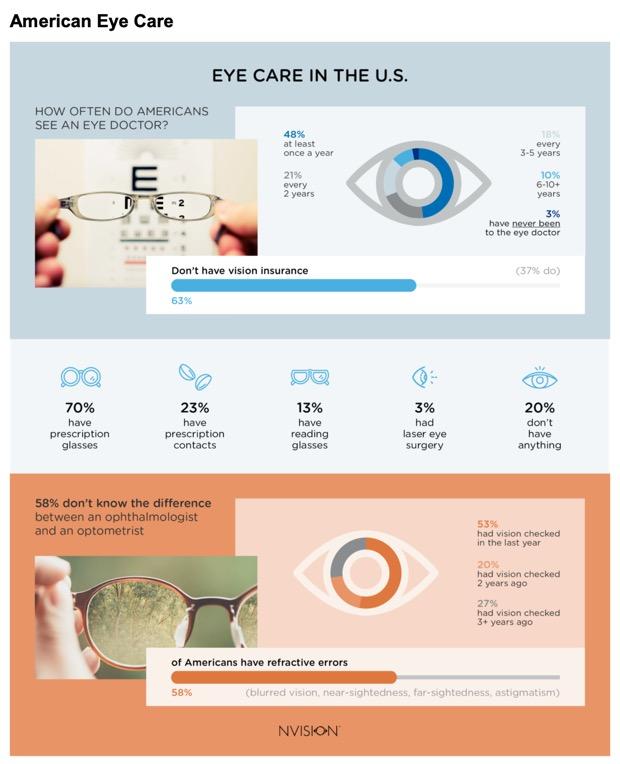
New Reg Reduces Medicare Coverage Gaps
Starting in 2023, benefits to kick in sooner
A new federal regulation will keep 65-year-olds from having to wait for their Medicare coverage to kick in regardless of when they apply during official enrollment periods. The rule, finalized on Oct. 28, also provides several new special enrollment windows, including for people who, through no fault of their own, didn’t sign up when they were supposed to.
The new regulation implements Medicare enrollment changes included in the sweeping appropriations law Congress passed in late 2020 and will take effect Jan. 1.
Starting next year, as long as you apply for Medicare during any part of your sevenmonth initial enrollment period or during the general enrollment period, your coverage would take effect beginning the following month.
More info: https://www.aarp.org/health/medicare-insurance/info-2022/enrollmentcoverage-gaps.html
JANUARY 2023 CALIFORNIA BROKER | 7 CalBrokerMag.com
For Best Results:
Write Out Your 2023
Sales Plan
The best sales plans begin with the end in mind. This simply means that you start your sales journey by establishing where you want to be at the end of the year and setting milestones to be reached along the way. Your marketing and sales activities will provide the foundation you need to move from the planning to the realization stage.
Writing down your plan — as opposed to just kicking it around in your head — makes it more real and actionable. Moreover, it allows everyone on your team to see the big picture, embrace the same goals and row in the same direction.
Read more: https://connect. comptia.org/blog/10-steps-fordeveloping-an-effective-2023sales-strategy
IRS Releases 2023 Cost-of-Living Adjustments for Health FSAs, Transportation Benefits, Adoption Assistance & More

The IRS has released the 2023 cost-of-living adjustments (COLAs) for a wide variety of tax-related limits, including limits relating to health FSAs, qualified transportation fringe benefits, qualified small employer health reimbursement arrangements (QSEHRAs), adoption assistance, DCAPs, the small business health care tax credit, the premium tax credit, and Archer MSAs. From isolved: read full article here: https://bit.ly/3uBOQGs
BEST HEARING AIDS FOR 2022:
Reviews and Pricing
Shopping for a hearing aid but not sure where to start? Check out this guide to the best hearing aids for 2022, including prices, features, and how to choose.
In a survey of 1,000 hearing aid users, 87.4% of people consider their hearing aids a worthwhile purchase, but over 50% of them were hesitant to buy because of cost.
To help combat this issue and provide the most comprehensive guide to hearing aids, Everyday Health spent over 1,000 hours user testing and researching hearing aids. We had our findings reviewed by an audiologist and have published that guide here: https://www.everydayhealth.com/healthy-living/besthearing-aids/
A new class of antidepressant works in 2 hours
The potential new drug is in a class of its own, as it works differently than any other antidepressant on the market. Major depressive disorder is one of the most common mental disorders in the U.S., affecting more than 8% of adults. Scientists have developed a new type of antidepressant that works differently. Testing their drug in mice revealed that antidepressant effects emerged within two hours with no hint of adverse side effects. Read more: https://bit.ly/3uDLFy1
8 | CALIFORNIA BROKER JANUARY 2023 CalBrokerMag.com
CURATED NEWS FROM THE INDUSTRY
Ready to Comply in 2023?
Use BenefitMall Compliance Guides
To help brokers guide their clients through compliance issues, BenefitMall has published a free 2023 Compliance Calendar for Group Health Plans (https:// bit.ly/3FBGvb5). The calendar highlights key dates throughout the year and includes links to the relevant government forms. Brokers can add their logos to the calendar before sharing with clients.
Additionally, BenefitMall is offering free Large Group (https:// bit.ly/3FDWUwM) and Small Group (https://bit.ly/3FDWUwM) compliance guides, covering updates to the Affordable Care Act, as well as various disclosure, notice, and reporting requirements. As with the compliance calendar, the guides can be customized with broker logos.
BenefitMall’s white-labeled educational materials and clientready collateral make it easy for brokers to serve as trusted advisors to clients, moving from periodic transactions to year-round relationships.
Read more here: https://bit. ly/3uF0sbW
SECURE ACT 2.0 WILL MAKE RETIREMENT SAVINGS AUTOMATIC — HOW EMPLOYERS CAN PREPARE
SECURE Act 2.0 is currently awaiting a final vote in Congress (as of 12/6/22) — the pending legislation is anticipated to be a package of several retirementrelated bills, expanding on provisions laid out in the original SECURE Act, which passed in 2019. Learn more. https://bit. ly/3Phmkn5
3 Ways to Customize Content Strategy for the 50-Plus Demographic
Many over 50 often look, feel and act younger than traditionally portrayed. Remarkably, the 50-plus demographic controls about 51% of consumer spending.
While huge in size, the demographic isn’t a monolith. There are no hard and fast rules. However, there are a few guidelines to keep in mind to appeal to each life stage.
In their 50s, consumers are likely time-constrained, sleep-deprived and on the go 24/7, juggling jobs, kids, caregiving, personal interests and financial responsibilities. Take a look here. https://www.adweek.com/brand-marketing/3ways-to-customize-content-strategy-for-the-50-plus-demographic/
OCAHU Legislative Updates from Shore to Shore Jan. 10, East Anaheim Community Center
CAHIP Annual Legislative Update Online Webinar. Jan. 18, 10:30-11:30 am PST
NAHU Live Virtual Corporate Wellness Certification Jan. 24, 10:00 am-1:00 pm PST
70th Annual Will G. Farrell Award & Leadership Recognition Feb. 23, 11:30 am-1:30 pm PST by Zoom sponsored by NAIFA-LA and FSP
Info: janet@wifs-losangeles.org
WIFS-LA Women’s Forum “Embrace Empowerment” Mar. 4, 9:00 am to 1:30 pm PST, by Zoom Info: janet@wifs-losangeles.org
Ellevate Women’s Leadership 2023 Summit March 13-15, Las Vegas area
CAHIP Capitol Summit May 8-10, Sacramento
JANUARY 2023 CALIFORNIA BROKER | 9 CalBrokerMag.com



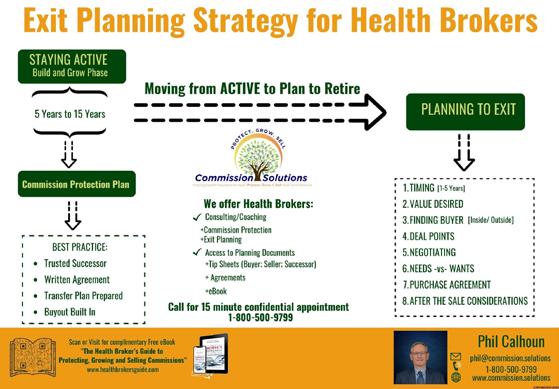



Look Develop a succession plan so you reduce surprises Have a no obligation 15 minute call with a succession planning pro 1. 2. 3. EXIT PLANNING PATHWAY SION SOLUTIONS 800-500-9799 www.commission.solutions T A K E Y O U R B U S I N E S S T O T H E N E X T L E V E L T A K E Y O U R B U S I N E S S T O T H E N E X T L E V E L Our Commitment is to respect your book of business and treat your questions with confidentiality. Our broker clients trust us and the processes we use, and our team delivers results. With over 60 years of experience you are in good hands with our team. CLIENT ENDORSEMENT
: "My payments are on time and accurate which confirms my trust and faith in the Team and process."
terms of our agreement have consistently been met and my confidence in Commission Solutions work continues."
decision to leave the Medicare business and sell my commissions, I chose Phil and his staff at Commission Solutions, and
dealing with them." Health insurance professionals have two things in common, they all built their book of business over time with energy and they all had a successful succession to retirement with our professional expertise. When looking to sell, the usual timeline is two to three years.
is needed to locate buyers, vet the buyers, negotiate the price and terms of the purchase and buyout, put an agreement together and
put in place a client transition plan. COMMITMENT Scan or email to schedule your free 15 minute call phil@commission.solutions
Lee
Mary: "The
Paul : "When I made the
I've enjoyed
Time
then
IS CMS RECORDING RULE CAUSING YOU ISSUES? LET US KNOW.
Please answer our four survey questions
CMA’s new requirement for annual enrollment period (AEP) involves recording calls with Medicare clients. To comply, health insurance professionals need to figure out how to not only record calls compliantly but to download calls on demand. When assisting clients with MAPD and PDP plans, the new call recording requirement has generated some responses.
Here is a sample of one broker’s experience.
1) Have any clients opted out of the recording? What percent?
None of my clients have objected to being recorded. They understand and are used to the recorded calls through customer service lines.
2) Scale of one being “not well” to 5 “just fine,” how are the required recordings going so far?
My clients are fine with being recorded but a number are annoyed that I cannot set appointments or review other coverage issues and plans without calling through the system’s recorded number.
3) Scale of one being “not at all” to five “totally agree,” do you now think recording calls is a best practice that benefits your clients and you?
The new call requirements create more administrative and time-consuming work. I must enter the individuals in the database to be able to call from it. This causes delays in my turnaround time for service, a key unintended consequence.
4) Did your FMO help you get the recording setup? If not how did you do get ready?
The call system is provided by my FMO. Some flaws exist which I hope can be resolved. It should have a good identifier
— such as my name — change when the call appears as “caller not known” or as spam so the prospect/client will pick up the call. This would eliminate the need to have to call the individual and tell them that I will be calling them with those identifiers.
Added comment: I do like the ease of the system for making or receiving calls, the electronic records created and records management for the clients and prospects. It is important to note that with the number of unsolicited and general spam calls, the Medicare beneficiary is very wary of calls they are receiving under this new call system. This often makes me look like one of the bad actors instead of a trusted advisor (the agent of record).
To share your experience, please respond to our survey: “Call Recording: How Was your Experience.”
Here’s the QR code to our very brief 4-question survey.

or you can go online here: https://bit.ly/3tHDgcv download the questions and email them to publisher@calbrokermag.com.
We will keep the survey open through January so finish AEP, take a break and please take a moment to complete the survey.
The results will be posted in all Cal Broker media — website: calbrokermag.com, Insurance Insider eNewsletter and our monthly magazine.
No Cost Solution Available from MedicareCENTER.com
MedicareCENTER.com is a proprietary software platform, designed to deliver a crucial new solution that is incredibly simple to use — Call Recording! Agents needing a smart and efficient way to stay compliant can use the MedicareCENTER’s Call Recording program. It’s easy to seamlessly record all sales calls, store the recordings compliantly and download calls at any time, from anywhere. This solution is built just for Integrity agents and available at no cost in MedicareCENTER at medicarecenter.com/welcome
Watch a brief video to learn how Call Recording in MedicareCENTER can help agents stay compliant and have more time to focus on what they do best — serve Americans!
https://www.integritymarketing.com/announcing-call-recording-in-medicarecenter/
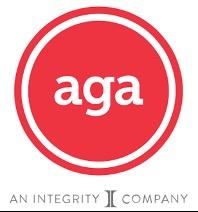
JANUARY 2023 CALIFORNIA BROKER | 11 CalBrokerMag.com
The 5 Must-Have Marketing Campaigns Your Insurance Business Needs in 2023
BY JEN DEVORE RICHTER
To make the most of your marketing budget and maximize results for your efforts, start with knowing exactly which marketing campaigns you need and practice consistency over time. As a busy insurance professional who doesn’t have a lot of time to figure out what to do, it can feel overwhelming as you start a new year of planning.
To make marketing simpler, here are my recommended five must-have marketing campaigns your insurance business needs in 2023:
Internal pieces to increase customer spending: Do you have events planned for 2023? What about special program offers, new product launches, or new services being added? Don’t forget to create specific campaigns to market to your internal and existing audiences.
There you have it! The five marketing campaigns you must have for 2023.
If you’re not sure where to start or would like expert advice on planning and executing these campaigns, there are many resources available. AND I’m here to help.
Connect with me and download a free 2023 Marketing Action Guide at www.jendevore.rocks
Subscribe for free weekly marketing training videos on YouTube here: https://www.youtube.com/c/jendevorerichter
Let’s break them down one by one.
New Lead Acquisition Campaign: This is the strategy for attracting and acquiring new leads at the top of your sales funnel. This includes online audience and community building plus email list building to turn top-of-the-sales cycle “suspects” that are just starting the journey with you into hand-raising interested prospects.
Referral Campaign: Your strategic partners deserve a focused and well-thought-through strategy for how you plan to stay topof-mind with them. Don’t rest on your laurels on this campaign. Plan for exactly how, when, and why you are going to ask for referrals. Create a system out of this process and increase your referrals in 2023 by 10x.
Newsletters: Want to get attention and stay top-of-mind with your best clients? A monthly newsletter delivered straight to their mailbox will do the trick. It doesn’t have to be the boring type either. Mix it up! Perhaps a magazine-style printed or digital newsletter fits your brand.
Follow-up and reactivation campaign: Let’s face it. There is probably a whole list of older prospects who never pulled the trigger and former clients who could still use your services. It’s never too late to follow up! Create a follow-up and reactivation campaign to maximize return on investment on the money you spent to attract those leads in the first place.
JEN DEVORE RICHTER has been featured on top shows and stages for direct response marketers including Dan Kennedy’s Magnetic Marketing stage, Video Marketing World, and ClickFunnels radio. With a background working for NASA at Kennedy Space Center and a master’s in business management, her career expands over several industries including television, advertising, speaking, and magazine publishing. Jen works as an Outsourced Chief Marketing Officer (CMO), Marketing Consultant, and Speaker. In her field, she is well known for creating the original “magazine funnel” which turns an entrepreneur’s own magazine into 52 lead generation tools both online and offline.
Jen currently serves on the board of directors for the National Speakers Association – Colorado Chapter as the Director of Marketing and Member Communications. She was awarded the President’s Award from the National Speakers Association –Colorado Chapter in 2022.
She holds a Master of Arts (MA) in Business Management and a Bachelor of Arts (BA) in Communication Arts/Public Relations.

12 | CALIFORNIA BROKER JANUARY 2023 CalBrokerMag.com
1. New lead acquisition campaign 2. Referral campaign 3. Newsletters campaign for your top clients 4. Follow-up and reactivation campaign 5. Internal pieces to increase customer spending

Change the Way You Sell Medicare with Social Media Branding
BY SHAUNA HALTOM
Why Social?
Let’s take a step back. What do Medicare beneficiaries want when looking to get a plan through an agent?
● Good to best coverage, depending on individual’s health needs
● Right price, based on a budget and fixed income
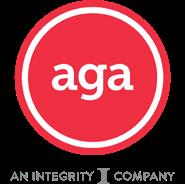
● Great service, based solely on you Your expertise will take care of coverage and price. Technology can help the service by showing prospects and customers your authenticity, authority and availability.
Authenticity: Social media is a good way to create transparency. You can make your personal brand more relatable by posting pictures of your community involvement or sharing some fun links that could resonate with your audience. Put your personality on display to lay the foundation for a relationship.
Authority: Have a steady stream of educational resources available to your social audience and they’ll start to see you as their reliable Medicare expert.
Availability: Social media is a great space to answer questions, respond to comments and offer current client support. It’s okay to create a dialogue with individuals on social media, so long as
it remains educational and helpful. But be careful about soliciting Medicare through social media. See more on that in the compliance section below.
Which Social Platforms?
The numbers are in, and baby boomers love Facebook. Data from Pew Research Center states that 72% of online American adults use Facebook and 70% of all Facebook users are on the social platform daily.
Facebook is an ideal platform for all types of content.According to DigitalTrends, baby boomers are 19% more likely to share content on Facebook compared to any other generation— making the case that Facebook’s demographic is getting older. You can use Facebook to post all things relevant to your brand and start getting more exposure.
LinkedIn is known as the most professional social network platform. To keep your brand authentic, you should have a complete profile on there. Include your work history, skills, causes and groups you’re interested in. LinkedIn Groups are an excellent way to connect with other business professionals in your area and niche (which is a good opportunity to start seeking out a professional referral network). You can also use LinkedIn Pulse to publish helpful articles on Medicare.
14 | CALIFORNIA BROKER JANUARY 2023 CalBrokerMag.com
MEDICARE
sponsored by
opportunity! How to leverage social media branding to boost exposure and get more Medicare leads and referrals
Big
Google+ isn’t irrelevant. An active Google+ profile can do wonders for your local search rankings. Using hashtags like #medicarebroker or #medicareadvantage can help your page get pulled in under search results for those terms. More specific hashtags such as #medicareagentanaheim will work to establish your local presence. You can also use Google+ to explore other users and groups to see what’s going on in your community, and to target individuals for a professional referral network.
YouTube is great opportunity for Medicare brokers. You can make YouTube videos explaining how to choose the best plan, the history of Medicare, or the difference between Medicare Advantage Plans and Medigap policies. Get creative and let your personal brand shine through. Promote your YouTube videos on your other social platforms or in a client newsletter.
How to use social media for personal branding
Content.
What you post is entirely up to you. But don’t make your feed overly promotional — mix it up with educational resources, tips and advice, client testimonials, news announcements, recommendations and (appropriate) humor. When it comes to when and how often to post, check out this article by CoSchedule: coschedule.com/blog/how-often-to-post-on-social-media
Get found.
The main goal of being present on social is to expand your brand awareness. You can make it easier to be found online when you use relevant search terms in your social profile descriptions. Keywords like: Medicare Advantage, Medicare Supplement, Medicare broker and Medicare agent are important to include in your brio to make your pages relevant online searches. The more relevant they are to terms people are searching, the more likely your page will show up in search results. If you have something of value that could create leads for you (like a YouTube video), promote your content to target groups. This helps you to “get found” more easily. Social media also makes targeted ads easy. Google Facebook advertising and LinkedIn advertising to see how they may work for you.
Remain consistent.
Consistency is key. Based on what your personal brand represents, develop a brand voice and tone to use. Always use same look and feel throughout all platforms. Hubspot offers some good visual marketing tips you can adopt into your social media branding.
Promote everywhere.
Always encourage people to share your content — you want your content to grow legs and run as far down the social space as possible! Link to your social profiles in your email signature to bring traffic to your pages. You can also include them on your direct mail brochures and business card.
Automate.
If you’re really looking to delve into a consistent social media strategy, you can automate your posting schedule through a program like Hootsuite or Buffer.|
What do we always say? Always practice with compliance
Before you start executing your social media branding strategy, make sure your planned activities are compliant per CMS guidelines. When prospecting and marketing on social media, look to CMS rules on in-person sales and print marketing.
● All marketing posts on social media must be approved first.
● Targeted ads must comply with CMS marketing rules.
● If an individual follows your page, likes or comments on an activity, Medicare brokers cannot take this as an “okay” to solicit Medicare to them.
● Medicare brokers cannot solicit Medicare to individuals who have not expressed interest.
● If someone reaches out to you for more information, provide a SOA form
Google Medicare Marketing Guidelines for more information.
All in all, your clients are in the social space and you should be too. Use social media branding to add credibility to your brand, showcase your true value and get more quality Medicare leads and referrals.
Need help with your social media branding?
Resources:
● Complete Insurance Brokers Guide to Personal Branding: appliedga.com/blog/personal-branding-medicare-agents/
● appliedga.com/blog/medicare-broker-social-media-branding/
● appliedga.wpenginepowered.com/wp-content/uploads/2016/12/AGA-LinkedIn-Profile-Checklist.pdf
SHAUNA HALTOM has been AGA’s marketing director since 2009. She is responsible for the development and management of agency B2B and B2C marketing campaigns, serving brokers through community events and grassroots marketing campaigns that include direct mail, database marketing, email and digital marketing.
Contact: shaltom@appliedga.com Website: https://appliedga.com/

JANUARY 2023 CALIFORNIA BROKER | 15 CalBrokerMag.com
6 Common Mistakes Insurance Brokers Should Fix for 2023
 BY TOM AVERY
BY TOM AVERY
For most people, the new year is about looking forward. For insurance brokers, it’s time to breathe a sigh of relief now that the madness of Q4 is done — and you can finally take that well-deserved rest.
Not so fast!
Before you leave 2022 behind, it’s important to take time to reflect on what you learned to prepare for success in the new year. How successful Q4 2023 is will depend on your work in the three other quarters leading up to open enrollment.
In the spirit of reflection, here are the top mistakes brokers made last year that might have lost them clients — and how they can avoid making those same mistakes this year.
16 | CALIFORNIA BROKER JANUARY 2023 CalBrokerMag.com
PROFESSIONAL DEVELOPMENT
Take time to reflect on what you learned in 2022
Mistake 1:
You only talked to clients during open enrollment.
You are your client’s agent of record all year long, not just during open enrollment. You should be in touch with them regularly to better understand what’s going on with their employees, help them address current challenges, and anticipate future needs.
And if the client isn’t responding to your attempts? Follow up! Learning why they’re so busy — or why they’re avoiding you — can help you address any issues the client is experiencing.
And it should go without saying — if your client reaches out to you, be sure to respond in a timely manner.
Mistake 2:
You didn’t address the client’s core HR challenges.
Keeping in touch with clients regularly helps you spot areas where you may be able to help them with current challenges.
● Is the employer struggling to recruit new employees? Help them put together a more competitive benefits package.
● Has the employer noticed a need for a particular line of coverage among their employees? Give them information about additional lines of coverage, such as pet insurance or short-term disability.
● Is the employer looking to keep costs down? Be proactive about their options.
By helping the client address their top concerns, you can position yourself as an invaluable member of their business.
Mistake 3: You didn’t help employees understand their benefits.
While many employees claim to want better benefits coverage, part of the problem may be that they don’t understand what’s covered and how to use their insurance.
Providing clients with resources that help employees better understand how to use their benefits can increase overall satisfaction with benefits packages without raising costs for the employer
(increasing their satisfaction with you, too).
Prepare a benefits book that includes information such as the plan’s benefits, terms, conditions, limitations and exclusions, and schedules of benefits.
Mistake 4:
You left compliance for the client to handle.
Is compliance technically the employer’s job? Yes. But compliance is an excellent area where you can go above and beyond as their broker.
Clients have varying levels of experience and resources to help them ensure they adhere to the many benefitsrelated regulations; they may be pretty upset to get hit with a fine only to hear you say, “That’s not my job.” Wrap docs are an easy way to pull together client plan information all in one place to keep clients in compliance.
Mistake 5:
You tried to minimize the compensation disclosure discussion
In 2022, insurance brokers and consultants were required to disclose their expected commissions related to all group health plans and individual health insurance policies. How did the conversation go? Were your clients surprised to learn what you were earning, and how?
Commissions can be a tricky conversation, but not if you’re prepared. Deliver your broker compensation disclosure along with talking points about your service and what you’ve done to serve the client, like helping build more competitive packages or handling compliance.
Mistake 6:
You manage your client data in separate systems.
How many logins do you need to access all the information you have about a client? There’s the benadmin system, CRM, document management, and of course, your email. That makes it too easy for vital information and important to-dos to fall through the cracks. Clients typically don’t love it when you have to ask for the information they’ve already provided, or when you forget to take care
of that important enrollment task.
An agency management system connects client, plan, and employee data so you only have to enter information once: company information, plan details, group numbers, employee details, dependent details, and more.
Don’t make these mistakes again in 2023.
Many of these mistakes are rooted in the assumption that brokers only need to do the minimum to retain their clients. In the past, that may have worked. But smart brokers are leveraging automation and technology to handle routine tasks so they can focus on solving big problems for their clients. Those brokers are learning from their mistakes—and reaping the rewards.
Wishing you a happy and successful 2023!
TOM AVERY is the founder of Innovative Broker Services, a boutique brokerage company and a Top-10 Employee Benefits Agency for 12 consecutive years (Sacramento Business Journal).

Tom is also the founder & president of Signal Sync, an insurance industry SaaS and agency automation solution designed for the independent agency. Tom continually writes regarding the many challenges faced by today’s agencies and has developed Signal Sync to overcome these challenges.
Contact: Tom.Avery@innovativebroker.com www.innovativebroker.com www.signal-sync.com
JANUARY 2023 CALIFORNIA BROKER | 17 CalBrokerMag.com
Insurance Trends:
U.S. versus the World
BY JAMES MACDONALD
The U.S. has a well-established insurance market which blends traditional agent-sold approaches, direct mail, phone and online marketing strategies. But what’s the picture for 2023? And why are American consumers increasingly utilizing online services and leveraging their data more than ever before?
We spoke to global InsurTech company ReMark about the Global Consumer Study (GCS) 2022-23, their new research into consumer attitudes. They walk us through three key consumer trends U.S. insurers need to be aware of in the coming year, and how attitudes towards insurance in America differ from those around the world.
They also bring us up to speed on the growing importance of consumer mental health and why employers and insurers alike can no longer afford to turn a blind eye.
What is the GCS?
ReMark’s Global Consumer Study (GCS) is an annual global survey of consumer attitudes towards insurance, starting in 2014. It gives an insight into major consumer trends on topics like artificial intelligence (AI), data privacy, health and even telematics.
The GCS 9 — this year’s edition — was based on responses to an online survey of 12,728 consumers drawn from 22 key insurance markets around the world. Fieldwork was conducted in April 2022 by ReMark’s market research partner Dynata.
The sample and methodology for each market aim to be representative of consumers or potential consumers of insurance, based on national sets of demographics parameters (age, gender, and region).
Insurance Literacy: Find out how much Americans know about insurance.
So, how much do Americans know about insurance?
In this year’s GCS, we tested people on their insurance literacy. We learned that U.S.-based consumers had a slightly higher level of insurance knowledge than the global average (6.61/10 versus 6.25/10).
However, this knowledge is not evenly split across generations: while Silent Generation (1928 – 1945; 77 – 94) respondents in the U.S. achieved an average score of 8.52/10, their Gen Z (1997-2012; 10 to 25 years old) counterparts scored just 4.99/10. Generational knowledge gaps are common in this year’s results, but appear more pronounced in the U.S.
18 | CALIFORNIA BROKER JANUARY 2023 CalBrokerMag.com
INSURTECH SURVEY
It should also be noted that multiple online points-of-entry are being used by American consumers. Our U.S. respondents most commonly used online services to get an insurance quote or recommendation (34.5%), followed by uploading personal details or documents (29.8%) and paying an insurance premium (28.8%).
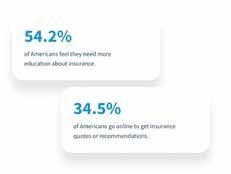
The data here are broadly similar to global trends, indicating that American consumers are very much intertwined with a global movement towards digitisation. Interestingly, despite good knowledge of insurance, the majority of U.S. respondents told us they still desire more education about financial services (54.2%).
Take away: The key products where further education may be useful are in the area of pensions and insurance. This is where U.S. consumers felt their knowledge was weakest. This could be an exciting opportunity for American insurers to make a real impact for their consumers over the next few years.
(76.7%), respectively. In each case Americans felt more comfortable doing this than the global average respondent. The possibility of a discount was the main driver here, with three quarters of U.S. respondents interested in the chance for reduced insurance premiums in exchange for sharing this data with insurers.


When making a claim, the most popular method is via phone for older generations but online for Millennial (1981-1996: 26-41 years old) and Gen Z respondents.
Take away: Given that some U.S. insurers still only offer phone-based claim processes, this highlights the need for insurers to digitize to attract next-gen consumers.
Health apps: How health app usage is split along gender lines in the U.S. American women in particular are keen users of health apps.
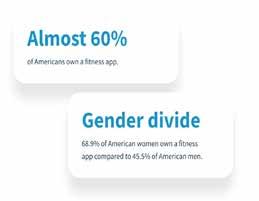
Data from this year’s GCS show the use of health and fitness apps is only increasing, with more than half of global respondents having a fitness app (51%). In the U.S., the popularity of these rises nearly another 10%.
Curiously, women seem to have a far greater appetite for general fitness apps than men, with 68.9% of American women owning one, compared to just 45.5% of American men.
Our research showed that Boomers and Gen X use general fitness apps more than Millennial and Gen Z respondents in the U.S. — though this may be explained by considering that many older individuals turned to health apps as a way to stay fit during Covid-19.
Take away: For insurers, the warning here is not to fall into the assumption that younger generations will be more likely to use health and wellness apps. Indeed, our data show that all age groups in America (possibly apart from the Silent Generation) show a desire to use them.
Americans are happy to share data in exchange for benefits.
U.S. respondents showed a willingness to share data with insurers to enable them to assess risk. Interestingly, 80.5% of them felt either comfortable or very comfortable in sharing information about employment. insinsurers to enable them to assess risk. Interestingly, 80.5% of them felt either comfortable or very comfortable in sharing information about employment. This was followed by an openness around sharing previous claims data (79.2%) and health check-up data
A deeper dive into Mental Health and Insurance
Living through a pandemic has taken its toll on mental health. The World Health Organization’s Global Burden of Disease 2020 study estimates that it has led to a 27.6% increase in cases of major depressive disorder and a 25.6% increase in cases of anxiety disorder.
The full impact of the pandemic on mental health has yet to be fully understood but our research indicates that, after a 43% spike in 2021, stress levels are falling to their lowest level since we have been measuring it. This year, 34% of respondents globally say they often or always feel stressed. In the U.S. this figure is comparable, at 35.6%.
As we have seen in previous years, reported levels of stress are inversely correlated with age. (Next page: Figure 30). Gen Z respondents were five times more likely to report being always or often stressed than those from the Silent Generation.
JANUARY 2023 CALIFORNIA BROKER | 19 CalBrokerMag.com
Data-sharing: What inspires American consumers to share data with their insurers?
As shown in Figure 31, exercise has a beneficial effect upon feelings of stress. Those who rarely exercise are more likely to complain that they are often or always stressed.
Cause and effect
Survey participants were asked about the potential issues that might lead to stress. For those who are not normally stressed this is, to some extent, a hypothetical exercise. Nevertheless, it shows some interesting generational differences. Overall, the two most likely causes were financial issues and health.

However, it is not surprising that at the generational extremes we see totally different answers. For Gen Z, finances are a likely cause of stress, whilst health is the least of their concerns. The opposite is true for those of the Silent Generation who are more acutely aware of their mortality and, in most cases, removed from exposure to pressures of work (Next page: Figure 32).
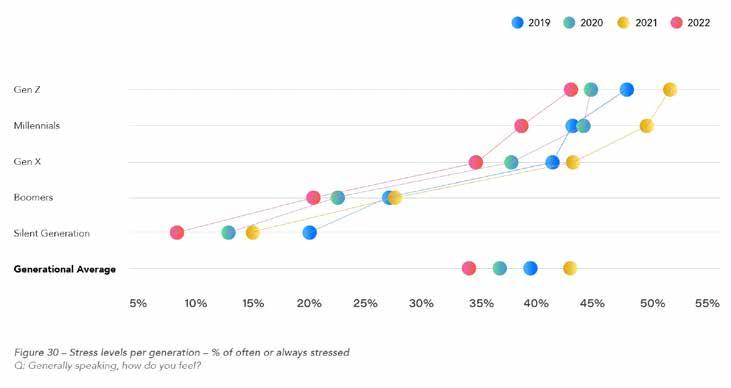
20 | CALIFORNIA BROKER JANUARY 2023 CalBrokerMag.com
The impact of mental health
This year’s survey saw a very modest decrease in the percentage of respondents that have suffered a period of mental distress that prevented them from doing their usual activities. This dropped from 45.6% in 2021 to 43.2% this year. This is not an accurate indication of the incidence of mental distress during the year because respondents are asked if they had ever experienced such an episode. Nevertheless, it is a positive sign that the numbers are relatively stable.
A similarly modest decrease is evident among those who have ever been diagnosed by a medical professional as having a mental health condition such as depression, panic attacks or anxiety. This year, 27.6% of global respondents say they have had a diagnosis, down from 28.3% last year.

America showed a similar drop, but maintains a higher rate of diagnosis among our consumers – 37.7% of U.S. respondents this year confirmed a mental health diagnosis, compared to 39.6% last year.
Looking at the findings by generation shows that the percentage of respondents who have had a professional diagnosis of mental illness decreases with age. These differences are more significant than they may first appear at first sight. The question asked was whether respondents had ever had a diagnosis of mental illness, so it is concerning that, in their relatively short lifetime, 38.5% of Gen Z globally reported having such a diagnosis, compared with just 12.5% of the Silent Generation.
JAMES MACDONALD is the Content & Communications manager for ReMark. Based in London, James works on developing content about how insurance can work more effectively for people. His academic background is in Human Rights & Sociology, with specialisms in Genocide & Propaganda Studies. Prior to working at ReMark, James ran communications for London-based charity Beacon Collaborative, which works strategically to increase philanthropy in the UK.

About ReMark
Established in 1984, ReMark is the world’s largest insurance consultancy helping insurers grow sustainably. Part of the SCOR Group, ReMark provides consumer insights, marketing and tech solutions. With 1 million policies underwritten per year, we have completed 12,000 campaigns and reached 1 billion customers. ReMark is the core digital solutions provider of SCOR aiming to create the best insurance experience for end consumers. Our award-winning solutions focus on marketing, underwriting, engagement, and claims innovation. ReMark counts 250 employees from 40 nationalities and 17 offices worldwide.
Contact: www.remarkgroup.com James.Macdonald@remarkgroup.com
JANUARY 2023 CALIFORNIA BROKER | 21 CalBrokerMag.com

DIVERSITY
Become a “Culturally Competent Benefit Champion”
 BY WAYNE GUZMAN
BY WAYNE GUZMAN
Be a superhero for your clients to inspire DEI awareness and practice in 2023
s the world has become so much more aware and knowledgeable about areas of diversity, equity, and inclusion (DEI), its importance in the workplace has expanded. Benefit professionals and consultants are challenged to evolve and incorporate methodologies to help guide employers with benefit designs that address DEI, as well as social determinants of health. The purpose of this article is to be a primer and provide guidance to those who desire to learn and become “Culturally Competent Benefit Champions.” This is an important aspiration for 2023 for us all.
For many years, benefit professionals espoused the value of wellness programs. They recognize the impact wellness could have on the bottom line of organizations by improving population health. Studies show these valuable and popular programs can ultimately bend the trend or slope of organizational healthcare spend. For many, this encompassed more than simply adding health and wellness programs to an employer’s benefit portfolio. It also included adding effective services that helped foster employee adoption and engagement. When helping people improve their health becomes a reality, it fulfills the vision of the organization and delivers promised outcomes touted by brokers and consultants.
In more recent years, benefit professionals have introduced the idea of Corporate Socially Responsible (CSR) benefit programs and design. Studies and anecdotes show that doing good (socially) and doing good (organizationally) are not mutually exclusive, but in fact are positively correlated and help increase overall organizational value.
Today with the rapid evolution of DEI awareness, education and workplace training, it is imperative to offer services, benefit design and programs that can improve an organization’s DEI bottom line. And ultimately, this means a better world for the humans that work in these organizations.
So, how do you begin? How do you acquire the skills to help your clients understand the importance of DEI and support them to put their values into action?
To start with, I recommend educating yourself. Make sure you feel relatively competent in your understanding of DEI, social determinants of health, and health inequities. Begin with an assessment of the current concept of DEI in the U.S. Please note that this is a growing and ever evolving arena, so you may find yourself feeling a bit overwhelmed. One place to start is to get involved in your industry professional organizations: National Asso. of Health Underwriters (NAHU) and CAHIP (California Association of Health and Insurance Professionals), as well as your local chapter DEI committees. Here you can dialogue with experienced professionals committed to achieving DEI. You will often find webinars, resources, and recommended materials to assist with your personal and
24 | CALIFORNIA BROKER JANUARY 2023 CalBrokerMag.com
To start with, I recommend educating yourself. Make sure you feel relatively competent in your understanding of DEI, social determinants of health, and health inequities. Begin with an assessment of the current concept of DEI in the U.S. Please note that this is a growing and ever evolving arena, so you may find yourself feeling a bit overwhelmed.
professional development. Also, your local Society for Human Resource Management (SHRM) chapter offers many excellent training tools for members and non-members alike.
I also recommend finding a mentor or working with a general agency and/or carrier partner who is well versed in this arena. They often offer programs and support to help in your quest to expand your awareness and become a “culturally competent benefits champion.” This work can be very far reaching. It can touch many areas of an organization with different areas of expertise. It is important that you develop a tool kit and benefit solutions that help you stay on task and help keep all involved focused on the major priorities and outcomes.
What should be in your tool kit?
A benefits assessment that incorporates a Social Determinants of Health lens.

Think about all the programs that you offer that can directly help in DEI areas. Additionally, it will be important to understand which of these areas may be having the greatest impact on the organization you are working with.
When should I have these conversations?
Initially this assessment should be done at a time apart from an annual renewal, so that an appropriate amount of time can be given to not only the evaluation but the beginning of the education necessary to demonstrate the value that a good DEI benefit program can offer an organization.
So just like other health professionals, it is imperative that
health insurance professionals conduct an annual DEI check up to determine the current state of health and improvements achieved by the adoption of new benefit programs and services.
As mentioned before, the challenge is that DEI has many tentacles and as such is intertwined into many parts of the organization, whether the organization is aware of it or not. So, it is important that benefit professionals utilize tools and programs to help not only identify gaps and areas of opportunities, but also prioritize recommendations designed to improve and deliver measurable outcomes.
In a follow-up article, we will take a deeper dive into some of these tools and educational materials that can help you advance your practice and help you to become the “Culturally Competent Benefit Champion” you strive to be. Until then, wishing you much success on your journey!
Senior Manager WAYNE GUZMAN, SHRMSCP, serves as Statewide Outreach for Blue Shield of California. He is chairman of the LAAHU DEI committee and member of the NAHU DEI committee.
Contact: wayne.guzman@blueshieldca.com www.blueshieldca.com

JANUARY 2023 CALIFORNIA BROKER | 25 CalBrokerMag.com
BY JOHN HASSETT

26 | CALIFORNIA BROKER JANUARY 2023 CalBrokerMag.com
Planning
for Small Business Owners FINANCE
Tax
Fundamentals
Planning for the new year includes reviewing your tax situation so you don’t miss opportunities to save money. Given that the average American spends more on taxes than any other category, good tax planning can make a huge difference. Entire books are written on this subject which can make the process overwhelming. Here are some basic steps that can lead to effective tax planning:
Step 1: Get your books in order
Accounting may be one of the more tedious jobs on the planet so it should be no surprise that people tend to procrastinate keeping up on all the bookkeeping. Unfortunately, accounting is the foundation of good tax planning. If you do not know where you are, it is hard to project where you will end the year in 2023.
• Make sure you have your bank and credit card accounts reconciled
• Review your balance sheet to see if there are items that need to be updated
• Review expenses paid from personal accounts to see if any business expenses were accidently paid from a non-business account
Step 2: Project your income
Come September it is time to reconcile your bank accounts so you can make an educated guess at where you will end the year.
• Run a year-to-date profit and loss in September
• Add forecast of revenue and expenses for the remaining part of the year
• Forecast non-business income and deductions
Step 3: Make an Appointment with your tax advisor
Ideally, this should be done early enough so you have time to make changes. If you want to change your tax advisor it is best to do this early in the year. Work through an initial intro process and then by October or early November you can make changes that will have an impact on 2023 taxes.
• Send your numbers over prior to the meeting
• Include a couple of notes of items you want to discuss
Step 4: What to cover in your meeting
Often, a good year in business leads to a bad year of taxes and a difficult year of business can end up being good news when it comes to taxes. There are ways to save money in all scenarios. Here are some of the most common tools:
• Review your business plan
• Review the tax impact of contributions
• Consider your retirement funds: 401(K), ROTH, IRA
• Look at making qualified charitable contributions ` directly from your IRA
• Gifts: Accelerate or defer gifting based on tax impact
• Consider Donor Advisor Funds as a powerful way to balance your gifting amounts
Investments: In most circumstances, taxes should not drive investment decisions, but they should always be part of the buy/sell decision process.
Ask your tax professional:
• For a projection of interest, dividends, and capital gains
• If you have loss carryforwards – if yes, how much?
• Should you make your capital purchases this year or next?
• Should you buy or lease a vehicle? Consider bonus depreciation. If the vehicle is over 6,000 pounds it qualifies for bonus depreciation. •
• Sometimes it is smart to elect out of bonus depreciation and save deductions for later years.
Don’t delay! Most decisions that impact tax savings need to be made well before the end of the year. Nothing is more painful than telling a client they could have saved taxes with simply adjustments to decisions they already made.
If you feel like it is too late…Well, let’s make sure it doesn’t happen again. Most businesses find Step 1 to be the Achilles heel. There are a lot of good selfhelp resources available. If you are too busy, consider outsourcing the job. There are many good accountants out there that help their clients maintain their books during the year.
Don’t know where to start? Give us a call. Malley & Hassett, LLP specializes in helping small businesses yearround.
JOHN HASSETT is a certified public accountant and the managing partner of Malley & Hassett, LLP. He has over 25 years working with businesses on accounting, internal controls, tax planning and tax compliance.
Contact: calcpapros.com Call 562-594-6601 for a free consultation

JANUARY 2023 CALIFORNIA BROKER | 27 CalBrokerMag.com
BY PAUL ROBERTS
Each year brings annual compliance responsibilities to employers regarding their health plans, federal Affordable Care Act (ACA) compliance, and COBRA responsibilities. It’s important for employers to be aware of — and adhere to — these responsibilities, supported by their health insurance brokers. An overlooked compliance item can result in significant non-compliance penalties in the federal ACA and COBRA spaces.
ACA Compliance: Applicable Large Employer (ALE) Determination

Each employer must annually determine whether it is an “Applicable Large Employer” (ALE) subject to the ACA’s employer mandate and related ACA IRS reporting responsibilities. Under the employer mandate, ALEs are required to offer all full time (FT) employees affordable group health coverage (“Minimum Essential Coverage”) that meets minimum value thresholds (a plan with 60%+ actuarial value). ALEs must also offer group coverage to FT employees’ dependent children up to age 26.
The employer’s ALE status must be evaluated annually on or around Jan. 1, in accordance with federal ACA law. To make the calculation, the employer must average the size of its workforce for all 12 months of the preceding calendar year.
For each month of 2022, the employer must count its FT employees and its full time equivalent (FTE) employees, then average those 12 results to get its final workforce size.
If the group size average is 50 or more FT + FTE, then the employer is an ALE for all 2023 — meaning it must comply with the ACA’s employer mandate for all of 2023 and must report to the IRS in 2024 on the coverage it offered (or didn’t offer) to FT eligible employees.
If the employer has fewer than 50 FT + FTE employees in this calculation, then it is not an ALE in 2023 and is not mandated to offer health coverage or report offers of coverage to the IRS in 2024.
An employer’s ALE status will remain in place for the entire calendar year going forward, regardless of fluctuations in its workforce size. Jan. 1 is the only time an employer’s ALE status can change.
The ACA considers an employee to be FT if the person averages at least 30 hours of service per week or 130 hours of service per month. FTEs are fractions of FT employees who, when totaled together, equal the equivalent of one FT employee.
To calculate FTE count, total the part-time employees’ hours of service for each month (using a maximum of 120
28 | CALIFORNIA BROKER JANUARY 2023 CalBrokerMag.com
COMPLIANCE
Annual 2023 Employer Compliance Responsibilities Significant non-compliance penalties are no joke!
SPONSORED BY
hours for each PT employee, even if he or she averaged 121-129 hours of service), and divide each month’s total by 120.
If you work with a general agent (GA), your GA may be able to provide you resources to help your clients make this determination.
ACA reporting responsibilities
If the employer determined on Jan. 1, 2022, that it is an ALE for all of 2022, it must now also report to the IRS on the coverage it offered (or did not offer) to any person employed FT for one full calendar month of 2022. ALEs usually complete this reporting during December or January using IRS Forms 1095 and 1094.
Copies of IRS Form 1095 must be furnished to employees by March 2, 2023. Copies of IRS Forms 1094 and 1095 are due to the IRS on/before the last day of February if submitting by paper, or on/before the last day of March if submitting electronically.
COBRA group size calculation
Employers that sponsor health plans must also determine COBRA responsibilities annually on or around Jan. 1, by evaluating workforce size under COBRA law. Unfortunately, it is a different (but similar) calculation than the ACA’s ALE count.
Employers that have employed at least 20 employees on 50% or more of the typical working days in 2022 are subject to federal COBRA law for all of 2023 if they sponsor a group health plan(s).
Employers domiciled in California, with California group health plan(s), that have employed fewer than 20 employees on 50% or more of the typical working days in 2022 are subject to CalCOBRA law for all of 2023.
When making the COBRA determination, both full-time (FT) and part-time (PT) employees are counted. Each PT employee counts as a fraction of a FT employee. To calculate PTs as FTEs in COBRA, the employer should total all PT employees’ hours of service and divide it by whatever the organization considers to be full-time.
Different benefits and administrative billing charges/fees on premiums are associated with federal COBRA and Cal-COBRA, so it is especially important for the employer to make the determination accurately at the beginning of the year. An employer should notify its carrier(s) and applicable COBRA Third Party Administrators (TPAs) of any changes to COBRA status as soon as the determination has been made.
Just like the ACA calculation, the employer remains in its COBRA category for the entire calendar year — regardless of future fluctuations in workforce size.
IRS controlled groups
If an employer has ownership in multiple businesses, its employees can be combined for purposes of determining group size — even if the businesses have separate tax IDs and are otherwise not related. It is critical for a tax professional to make this determination for employers in accordance with Internal Revenue Code Section 414, subparagraphs (b), (c), (m), and (o).
California’s Individual Mandate continues in 2023
It is also important to note that California is continuing its state individual mandate in 2023 and into the foreseeable future. The mandate requires all Californians to carry qualifying Minimum Essential Coverage (MEC) for the tax year, obtain an exemption, or pay a tax-penalty when filing California state tax returns. A one-time break in coverage is permitted for up to three months. The California Franchise Tax board released an online calculator to help Californians understand potential non-compliance penalty exposure in accordance with this mandate, which began Jan. 1, 2020.
Most other states do not have individual mandates. The federal ACA individual mandate applies to all 50 states; however, the noncompliance penalty is $0.00 as of 1/1/2019.
A commitment to you in 2023 and beyond California Broker is committed to helping you stay up to date with changes in the health insurance industry. Watch for future columns that can help in 2023.
PAUL ROBERTS is senior director of Education and Market Development at the Word & Brown General Agency. Established in 1985 and headquartered in Orange, Calif., Word & Brown is one the state’s largest independently owned general agents.
Contact: www.wordandbrown.com proberts@wordandbrown.com

JANUARY 2023 CALIFORNIA BROKER | 29 CalBrokerMag.com
NAHU Leadership Perspectives Shift to Embrace the Generations
In the December 2022 issue, I shared a conversation with two of my favorite mentors, Bruce Benton, past CAHU and NAHU president, and Pat Griffey, past NAHU president. I’m sharing a continuation of that conversation along with commentary by life coach Joe Navarro. Both Bruce and Pat have a passion for our association and its leadership. I was honored and curious to explore their experiences about years of leadership service at ALL levels — from local to national.
Continuing the conversation with favorite mentors Bruce Benton, past NAHU and CAHU and president and Pat Griffey, past NAHU president, with commentary by Joe Navarro
My final question was “what top three pieces of advice be to anyone interested in serving in leadership? Let’s remind readers about that.
Pat Griffey: First, keep an eye to the future and be open to new ideas. Honoring that WHY was one of the key elements of Vision 2025. I’m not that smart so I had to make a platform available to innovators to share ideas. Second – find a mentor and be a mentor. Third, allow time to dig deep and question your own preconceived notions, as opposed to taking the easy path because it is what we’ve always done. That’s not what’s going to get us where we need to be now.
Bruce Benton: Mine aren’t so different — no surprise. First — I’ve always loved the “servant“ leader approach — this is the approach I suggest for anyone interested in leadership. The true ‘servants’ I’ve met are in it for the right reason, they stay humble and they leave their ego at the door.
Second — I’ve always been big on clarity. Clarity is KING. I felt I could have done a better job explaining how NAHU operates from a government relations perspective — we are a non-partisan, unbiased organization of insurance professionals. Our role is to examine proposed legislation and its potential effects with a simple explanation of WHY. So simple that you could explain it to your mom without her eyes rolling up – to give legislators a clear perspective on why we feel a certain way about the effects of proposed legislation on the insurance market.
BY DAWN M C FARLAND
Third — be mindful of being extremely patient, tolerant and understanding of everyone you come across. Practice loving kindness and compassion, because we are all in this together.
I read an article in my research about leadership to see what Google and LinkedIn are saying about leadership. I really liked this article by Jossy Chako, “Only leaders of great courage and vision will intentionally consider the next 100 years and beyond.”
A couple of the questions he posed were particularly interesting to me.
30 | CALIFORNIA BROKER JANUARY 2023 CalBrokerMag.com
GENERATIONAL LEADERSHIP
PART TWO OF TWO
• What changes are required in your organization or leadership to become truly generational?
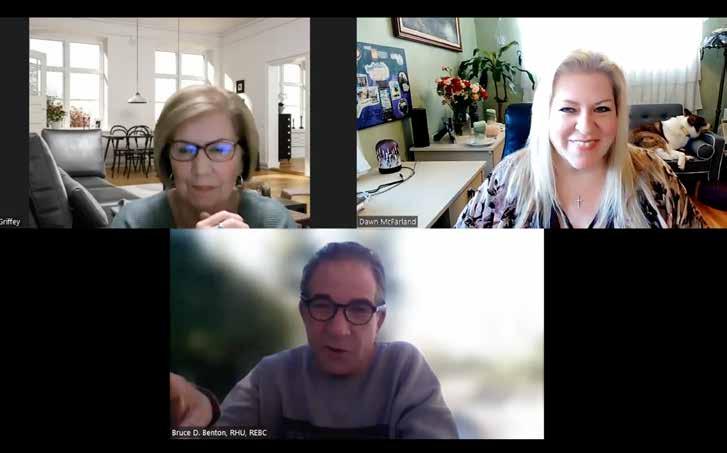
• List the names of those in the next two generations you are intentionally investing in.
• What is stopping you from giving at least 10% of your time investing in the next generation?
• If nothing changes, what will be your legacy 100 years from now?
• Make intentional decisions, knowing that you may not reap the benefits from them! This makes me think of the whole student loan forgiveness debate. What are your thoughts?
• In this divisive world we live in, and with light being shone on diversity, equity and inclusion, what do you feel leadership needs to be mindful of?
[Watch the full interview on https://youtu.be/qOHB6knoffk.]
JANUARY 2023 CALIFORNIA BROKER | 31 CalBrokerMag.com
Founder & President of Empart Jossy Chacko poses these questions for leaders to ponder
Dawn asked Joe if he could provide some thoughts after listening to the conversation.
Joe Navarro: Thank you, Dawn, for the opportunity to respond to your interview with Pat and Bruce. Your style is open and encouraging. I enjoyed listening to your conversation. Some of the most impactful comments that stood out to me were:
• Most can tell you what, some can tell you how, not as many can tell you why.
• Bruce was able to visit 26 chapters during his year as president of NAHU. Pat was not as fortunate due to Coronavirus during her year as president.
• It is important to understand both sides.
• Society has stepped away from respect.
• I am interested in what you have to say.
• Respect is important on both sides.
• Meet people where they are.
• Stay away from “we have always done it that way.”
• Be open to new ideas.
• Be mindful of people’s differences.
There is a lot more. I encourage readers to watch Dawn’s video of her interview with Bruce and Pat to learn more: https://youtu.be/ qOHB6knoffk
BY JOSHUA SCHNEELOCH
My focus today as a coach/mentor is to add to these messages.
I acknowledge especially important traits demonstrated in this interview — traits that Dawn, Pat and Bruce all have: true PASSION for what they do and the DESIRE to continue making a difference and contributing to the growth and health of the industry through its association leaders and members.
I have been blessed to interact with and learn from agents, brokers, sales consultants, carrier product specialists and association members throughout my career — a special group of people who keep on giving and really care about what they do and who they do it for.
I offer my sincere respect and appreciation to each of you for your efforts throughout the years.
Generations in the workplace today:
The 2022 LiveCareer Study of over 1,000+ respondents consisting of all generations found 89% considered generational diversity in the workplace as a positive element of work. The opportunity to learn from each other was viewed as a good thing for their careers by 87%. The study found job prestige was valued by the greatest number of respondents.
The LiveCareer study also found that as a result of increasing inflation and potential for recession, respondents also rated job prestige and job security as the highest priority in their careers.
Understanding that hybrid jobs and working from home is
also important to all generations, I would offer that NAHU/ NABIP is faced with a huge challenge and OPPORTUNITY meeting the diverse needs of all generations. Through your many experienced and knowledgeable members, you can offer a comprehensive, ongoing mentoring and training program to build future relationships.

[Editorial comment by Dawn: Here’s a shameless plug for the mentorship program NAHU/NABIP has had success with. Not many know about it yet — an example of a members only resource! https://nahu.org/membership-resources/mentorprogram.]
Here are 5 recommendations:
1
“We have always done it this way” is not what this proud organization, dating back to 1930, should be known for. Despite your many innovative offerings, some have historically looked at you this way. To open new space I would suggest a more positive and dynamic mantra of “Breaking All the Rules” as you go forward. It can be difficult and even scary at times, but as I have mentored numerous clients, once you start seeing positive results from your new “attitude” you will find it absolutely magical.
2
All generations are at a different place in life. All have different values and require additional appropriate assistance. Help them grow by meeting them where they are. You, more than anyone, understand them and as a result you will be seen as offering creative tools that will enhance their skills, grow their knowledge and bring out their hidden talents.
3
Create respect and new appreciation for your organization by committing to creating an “Army of Mentors’’ that is devoted to spending quality time and sharing experience with all generations. News will travel quickly throughout the business community. This can also ease the transition of leadership from more established members by identifying, fostering and appreciating younger leaders that can be groomed to take over. The new NABIP will become the go-to business entity for the future.
4
Learning from the past gives you so many new choices — if you are open to it. Take a leap of faith that NABIP can continue to exceed the needs of a changing profession with a vibrant and knowledgeable array of communications and programs that is not found elsewhere. While it separates you from the past it establishes a whole new viable professional group for 2023 and beyond.
Ask those on your team to elaborate on “Who are you?” “What do you do?” and most importantly, “Why do you do it?” This is one assignment I give all (including myself) each year. Asking these three questions alone will reveal more about you and all others on your team. It sets a tone for how you move forward together.
5
32 | CALIFORNIA BROKER JANUARY 2023 CalBrokerMag.com
Commentary from Joe Navarro, generational expert and life coach, past marketing guru for Warner Pacific and WellPoint.
The following data regarding the generations is offered to clarify Joe Navarro’s commentary.
GENERATION (GEN) Z:
2001 to 2020, youngest 2 and oldest is 21
GENERATION MILLENNIALS:
1981 to 2000, youngest is 22 and oldest is 41
GENERATION (GEN) X:
1965 to 1980, youngest is 42 and oldest is 57
GENERATION BABY BOOMER:
1946 to 1964, youngest is 58 and oldest is 76
As you have read, generations are at different places in their lives. Generation Z is entering the workplace; the Millennials are exploring the choices they have made up to this point; Gen X is entrenched in theirs but looking for ways to improve what they do; while Boomers are experienced and enlightened and because of their experiences feel they can keep contributing.
You are capable of reaching out to all.
BACK TO YOU, DAWN
Dawn: Thanks Joe for bringing the focus back to mentoring!
Here is my familiar membership pitch: if you are getting a paycheck in the health insurance industry, you should be a member of the National Association of Benefits and Insurance Professionals (as of January 1st NABIP - formerly NAHU). Even if that is not where you choose to volunteer, the small monthly fee is worth the advocacy done on your behalf and for your clients.
Happy 2023! May we have a prosperous and healthy year!
~Dawn
DAWN MCFARLAND is VP of legislation for CAHU (now known as CAHIP), president of M&M Benefits Solutions in Los Angeles and the vice chair for the Leadership & Development Committee for NAHU (now NABIP).
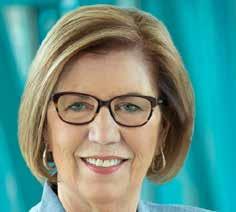

Contact: dawn@mnmbenefitsolutions.com 1(805) 701-1229
Contact: linkedin.com/in/paticiagriffey-rhu-rebc-a297b94 www.PatGriffey.com
Contact: linkedin.com/in/brucebenton www.genesisfinancial.biz
JOE NAVARRO, generational expert and life coach, past marketing expert for Warner Pacific and WellPoint

Contact: joeboomer65@gmail. com
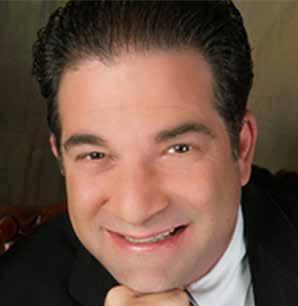
JANUARY 2023 CALIFORNIA BROKER | 33 CalBrokerMag.com
Past CAHU and NAHU president BRUCE BENTON, Owner, Genesis Financial & Insurance Services
Past NAHU president PAT GRIFFEY
Artificial Intelligence: Boogeyman or Butler?
BY JOSHUA SCHNEELOCH
As a business innovator, I am intrigued by artificial intelligence (AI), especially how it can help insurance agents and brokers grow — faster, smarter, and bigger. I recently spoke with industry leaders and pioneers in the burgeoning insurtech field, in December at the Money 2.0 conference in Las Vegas. There I received a leadership award for innovation, and moderated a panel of the industry’s top wealth creators on this same topic: “The Future Of Insurance Is Here — How Automation Is Transforming The Customer Journey.” In next month’s publication, I will share their insights and strategic recommendations for agents and brokers seeking rapid, sustainable growth in a rapidly evolving digital landscape.
Everyone tells me AI —automation’s big sister — has the power to transform the customer experience and create tremendous value for ambitious agents and brokers willing to innovate in a traditional industry. The rapid evolution of the industry will be fueled by the continued and extensive adoption and integration of automation, deep learning, and external data ecosystems. That’s the new age of AI. That said, let me hasten to warn you that we cannot ignore the concerns and fears of customers who don’t want their private and personal information to be used to exploit them.
As with all tools, the way we use them will determine results, meaning whether AI will be a boogeyman, confirming all consumers’ worst fears of misuse and exploitation, or more like a butler, who anticipates your every need and is always ready to serve you personally and predictably. In this article, I’ll share a few perspectives and approaches ambitious agents and brokers need to keep in mind, as well as what investors are looking for as more and more of them bet on the growing trillion-dollar insurance marketplace.
First, some basic trends at the intersection of AI and insurance: AI is merely one aspect of the technology central reality — Big Data. With the onslaught of massive troves of data and the ability to analyze and apply it instantaneously, we have moved from the age of information into the age of intelligence and insight. Yes, we can see the future — an ability which creates enormous value when used smartly, or the intelligent use of intelligence.
Insurance is, at its core, a data-driven enterprise, requiring the accurate calculation of risk and reward. According to a very recent McKinsey Report: Insurance 2030 — the impact of AI on
the future of insurance, AI and its related technologies will have a seismic affect on all aspects of the insurance industry, from distribution to underwriting and pricing to claims. Advanced technologies and data are already affecting distribution and underwriting, with policies being priced, purchased, and bound in near real time. Accordingly, data is fast becoming one of the most — if not THE most — valuable assets for any organization. The insurance industry is no different: how carriers identify, quantify, place and manage risk is all predicated on the volume and quality of data they acquire during a person’s and a policy’s life cycle.
The future of AI/Insurance
Most AI technologies will perform best when they have a high volume of data from a variety of sources. As such, insurance agents and brokers must develop a well-structured and actionable strategy with regard to both internal and external data. Internal data will need to be organized in ways that enable and support the agile development of new analytic insights and capabilities. The experience of buying insurance will be faster, and more convenient than ever before, with less active involvement on the part of the insurer and the customer. Enough information is known about individual behavior, with AI algorithms creating risk profiles, so that cycle times for completing the purchase of an auto, commercial, or life policy will be reduced to minutes or even seconds.
In the area of distribution, auto and home carriers have enabled instant quotes for some time but will continue to refine their ability to issue policies immediately to a wider range of customers as telematics and in-home Internet of Things (IoT) devices proliferate and pricing algorithms mature. Many life carriers are experimenting with simplified issue products, but most are restricted to only the healthiest applicants and are priced higher than a comparable fully underwritten product. As AI permeates life underwriting, and carriers are able to identify risk in a much more granular and sophisticated way, we will see a new wave of mass-market instant issue products.
As far as the future of underwriting and pricing goes, underwriting as we know it today will cease to exist for most personal and small-business products across life and property and casualty insurance. The process of underwriting will be reduced to a few seconds as the majority of underwriting is automated. These models will be powered by internal data as
INSURTECH
An insurance agent’s look into the future of AI and automation
34 | CALIFORNIA BROKER JANUARY 2023 CalBrokerMag.com
well as a broad set of external data accessed through application programming interfaces and outside data and analytics providers. Information collected from devices provided by mainline carriers, reinsurers, product manufacturers, and product distributors will be aggregated in a variety of data systems. These information sources will enable insurers to make decisions regarding underwriting and pricing, enabling proactive outreach with a bindable quote for a product bundle tailored to the buyer’s risk profile and coverage needs.
This is just a glimpse into the future of insurance in the new age of Big Data.
A tool, not a solution
It’s crucial to understand that AI is a tool, not a “solution” in and of itself. It’s a piece of the puzzle that must be applied to specific business requirements, such as fraud detection or claims automation, usually in the form of a software deployment. It’s the underlying AI that takes copious amounts of data, makes sense of it all and allows the software to present something useful to the claims handler or even handle the claim without human intervention — to the delight of the policyholder.
AI, yes, BUT don’t forget the human touch
In virtually all sports, eye contact is key to winning. Keep your eye on the ball, said the athlete. In business, the consumer is the ball. As I’ve learned — having sold technology, programming, security and now risk management — a commitment to your customer, your end user, the actual consumer of your product or service is essential to sustained success. My best advice to you as you delve into the world of AI is to avoid becoming tech-centric, or product-oriented, but rather be consumer-centric. Keep your eye on your customer. And make actual eye contact. Think of how you can use AI to anticipate customers’ needs and help them to prepare for the future, as opposed to getting caught in the weeds of tech talk. This means empathizing with them, and gaining their trust, like being a trusted butler — loyal, discrete, quiet, non-obtrusive — — not merely a bill collector. The human touch in insurance is a huge strategic differentiator and one I embrace in my company.
Everybody in the industry agrees that the future of insurance will be data-driven and analytics-enabled. But tomorrow’s topperforming agents and brokers will also excel at making human connections and applying personal touch at the right time. To a large extent, this is about empathizing deeply with customers. That means dedicating people and teams to understanding not only what customers might buy from you but also how they feel and what they value most in life.
According to David Connolly, EY Global Insurance Technology leader, in a recent conversation with Chetan Kandhari, Nationwide’s chief innovation and digital officer, at the EY Insurance Executive Forum, research shows that consumers value a sense of feeling protected. To deliver that powerful outcome, agents and brokers will need to retrain customers who tend to focus on price, thanks largely to billions of dollars of industry advertising. Appealing to higher-order needs may give agents back some pricing power.
That level of empathy is critical if agents and brokers are to address one of their biggest barriers to innovation: lack of
consumer trust. Consider all the deeply personal information consumers are comfortable sharing with their wealth advisors — all of their financial data — and their hopes and dreams. Now think about what insurers could do with such data — precision risk profiling, targeted pricing, lifetime customer value modeling, and tips for better living. Insurers that can dial-up trust with their customers will have a huge competitive advantage during a period of substantial change and intense competition. Today, a more nuanced and interdependent humantech dynamic has emerged. The consensus among forwardlooking executives is that human talent is every bit as important to future success as AI, machine learning and modernized processing platforms.
The role of the agent in the future
The role of insurance agents is changing dramatically with the evolution of technology and data analytics. The number of agents is declining substantially as active agents retire and remaining agents rely heavily on technology to increase productivity. The role of agents and brokers is becoming less sales oriented and more solutions oriented. Solve, don’t sell is my watchword. Agents will become more like process facilitators and product educators. And the better you are at anticipating clients’ needs, the more successful you will be over the long term, creating life-long relationships. I call it the “butler model.”
The agent of the future will be able to sell nearly all types of coverage and add value by helping clients manage their portfolios of coverage across experiences, health, life, mobility, personal property and residential. Agents will learn to use smart personal assistants to optimize their tasks as well as AI-enabled bots to find potential deals for clients. These tools will help agents to support a substantially larger client base while making customer interactions (a mix of in-person, virtual and digital) shorter and more meaningful, given that each interaction will be tailored to the exact current and future needs of each individual client.
I can hear an independent agent or broker saying, “that’s all well and good but how can independent agents and mid-sized brokers like me tap into AI and other hightech tools?” Insurtech companies, like White Wing, are creating amazing performance platforms designed to plug you into the power of data analytics, automation, digital data marketing, and smart decision-making. As the industry takes its time adapting and adopting new technology, thousands of agents and brokers are partnering with tech-solutions enablers to accelerate their businesses and compete at a higher level. More to come in my next article.
JOSHUA SCHNEELOCH is the founder and CEO of White Wing Insurance Solutions and White Wing Wealth and the author of the upcoming memoir, “The Favored Son, How a Black Orphan Conquered Europe on His Way to America.”

Contact: whitewinginsurance.com joshua@whitewinginsurance.com
Check out Joshua’s previous articles about White Wing in Aug., Sept. and Dec. 2022 issues.
JANUARY 2023 CALIFORNIA BROKER | 35 CalBrokerMag.com
Travel Smart
By Don Van Scyoc
After a tumultuous several years, it’s great to be able to say that travel is back! U.S. outbound flight bookings have rebounded to 95% of 2019 bookings, with destinations such as Canada, Mexico, Dominican Republic, the United Kingdom and Italy topping the list (World Travel & Tourism Council, July 2022).
As your customers are making itineraries and starting to pack their bags, it’s important to discuss if they’ve thought about their health insurance and whether they have adequate coverage overseas.
Travel insurance is NOT international medical insurance
Many of your customers may be familiar with trip cancellation insurance, especially in today’s world of airline and airport staff shortages. Trip cancellation insurance insures a financial investment in a trip, helping with items such as lost baggage, canceled flights and delays. International medical insurance (also referred to as travel medical insurance), on the other hand, covers the medical attention a customer may need while outside their home country — things like emergency care, telemedicine and medical evacuation/repatriation.
COVID-19 has reshaped international travel and increased awareness of the importance of international medical insurance. Some countries have implemented policies mandating proof of adequate medical coverage and insurance as a requirement of entry. Even the U.S. State Department encourages travelers to be insured by reviewing their domestic coverage and/or purchasing a travel medical plan. However, your customers may still board the plane lacking adequate coverage. Here’s why…
Many customers assume their coverage extends overseas
Many of your clients enrolled in a domestic plan believe that they will have seamless access to medical care overseas. That is often not the case. In fact, some domestic group plans offer no coverage, nor do most Affordable Care Act (ACA) plans. Even the best Medicare supplement plans have limited international benefits. It may be surprising to learn that the following benefits are not included with most domestic plans:
• Access to 24/7 assistance services to set up hospital stays and coordinate care
• COVID-19 medically necessary testing and treatment
• Access to a contracted global provider network
• Clear, extensive evacuation/repatriation coverage and
AD&D
• Direct pay (a cashless experience with no costly upfront payments for care)
• 24/7 telemedicine
and security profiles
The fact is that most domestic health plans are simply not designed to support customers abroad. Any claims your customers file overseas are considered out-of-network and may not be covered or reimbursed. Telemedicine is limited to only U.S.-licensed doctors. Customers who need to contact their insurer may only be able to do so during standard U.S. business hours. The list goes on.
Furthermore, U.S. health insurance is typically not recognized by overseas providers. This could mean your customers may have to pay in full for services upfront before care is given. A seemingly simple visit to the doctor and pharmacy could set customers back quite a bit; a fall, car accident or medical emergency requiring an ambulance and hospital stay could wipe out their savings. The financial and emotional impact could be devastating.
However, you can help protect customers from unwelcome surprises and the gaps that could occur when relying on domestic insurance internationally by setting them up with an appropriate international medical insurance plan.
How to identify customers that may need travel medical coverage
It’s not just one type of customer that needs international insurance. Think about all these scenarios (and several may overlap):
International travelers
Anyone vacationing falls into this category (some plans cover individuals to age 95), including students on spring break or study abroad programs and independent business travelers who take frequent trips abroad.
Digital nomads and location-independent employees
This is an exploding area in recent years, as the line between work and home is now blurred (or nonexistent, with some customers taking advantage of “work from anywhere” situations). Customers may include independent digital nomads who opt for a lifestyle of working remotely outside their home country or employees who work for an employer and make the personal choice to work outside their home country. This
36 | CALIFORNIA BROKER JANUARY 2023 CalBrokerMag.com
MEDICARE TRAVEL MEDICAL INSURANCE
Why more customers may need insurance more than you think in 2023
also includes employees taking “workcations” that combine work and leisure travel.
Expatriates
This can include a wide range of customers, such as: >individuals who live and work independently outside the U.S., >foreign nationals studying in the U.S. and looking to stay in the U.S. after their program has ended >U.S. college students soaking up a few more months of an international experience after their study abroad program has ended. Expats can also include specific groups, such as a yacht crew and missionaries, who need international healthcare solutions.
Medicare/Medicaid customers
These policies have limited coverage overseas. Outside the U.S., Medicare Supplement policies can carry a $50,000 lifetime maximum. Just one medical evacuation could max out a policy and place your customers at risk of needing more coverage. Plus, these domestic policies hold seniors responsible for covering the costs of their treatment until they file a claim for reimbursement (and then, in many cases, the policy will only pay for 80% of the cost). Customers are also responsible for coordinating their own care, which can be overwhelming for seniors battling potential health issues in a foreign city.
ACA customers
Most ACA plans offer no international health insurance coverage. Customers would be responsible for paying for all medical services out-of-pocket and may have care refused if they cannot afford to pay upfront.
Things to consider when evaluating coverage options
It’s likely evident that a lot of your customers could use your guidance with travel medical insurance. It’s important to talk to them about their travel plans before they leave the U.S., understand their travel needs and support them in selecting the best plan for their unique situation.
First, look at your customer’s existing plan and examine what it does and does not cover. The plan may have some international benefits, but chances are there are gaps in the coverage. If you work in an employer market, some employersponsored products do in fact extend coverage seamlessly overseas — but others do not.
Then start researching plan options from different travel medical insurance providers. There are multiple carriers who offer international coverage. Here are some things to look for:

• Is COVID-19 testing and treatment included?

• Does the plan cover pre-existing conditions?
• Does the plan have inside limits?
• What are the medical limits for medical evacuation and repatriation?
• Does the plan offer telemedicine access to multilingual doctors?
Also look for unique offerings that could benefit specific customers. For example, GeoBlue offers an app that can help with translating the names of medicines or communicating food allergies. Features like this could help customers avoid needing medical care when traveling and provide much greater peace of mind.
Proactively reach out to your customers
It’s a new year, and your customers may be thinking about travel related to spring break, summer vacations, work trips and even the next holiday season. Reach out to them and ask about their plans so you can support them if international travel is being considered. You can help them understand what coverage they may need now — before they travel — and plan accordingly. And while we’re talking about reaching out, you can also reach out for support! International medical insurance is complicated, and you don’t have to be an expert. Industry experts from the various providers can help you evaluate options and identify the right solutions for your customers. We’re here to help you ensure your customers have the coverage they need when traveling overseas.
GEOBLUE is the trade name for the international health insurance programs of Worldwide Insurance Services, an independent licensee of the Blue Cross and Blue Shield Association. Celebrating its 25th anniversary this year, GeoBlue’s purpose is to simplify the international healthcare experience for the globally mobile. GeoBlue members have access to one of the largest care networks in the world, coupled with high-tech, high-touch services that enable them to fulfill their international aspirations. Whether it’s executives doing business in Tokyo, students studying in Spain, or tourists traveling the world, the power of the Blue Cross and Blue Shield brand is always within reach. To learn more, visit about.geo-blue.com.
JANUARY 2023 CALIFORNIA BROKER | 37 CalBrokerMag.com
DON VAN SCYOC, VP, Individual Sales leads the sales and retention teams for GeoBlue’s individual short-term travel and long-term expat sales through direct and brokered channels.
BY PHIL CALHOUN
CALBROKER PUBLISHER
The premise of “The War on Small Business” by Carol Roth is that for years, government bureaucrats have been looking for ways to destroy small businesses. She outlines how they finally had their chance with the many actions taken around the coronavirus shutdowns.
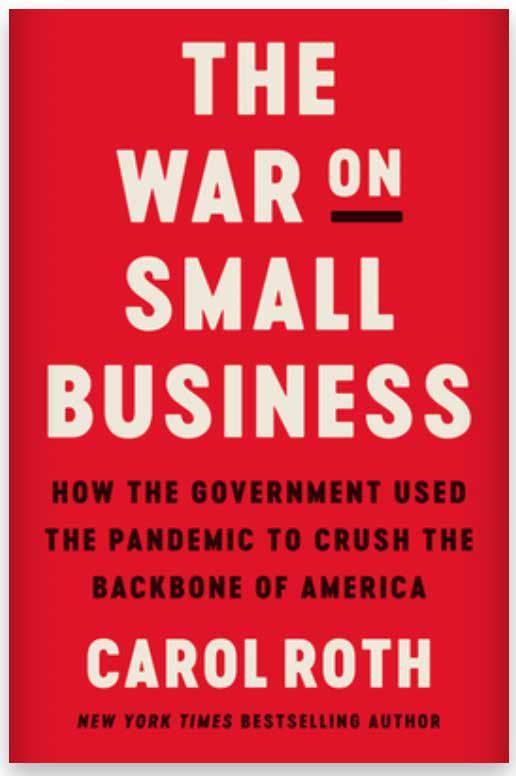
“In 2020, the American economy suffered the biggest financial collapse in history,” author Carol Ross puts forth. “But while Main Street suffered like never before, the stock market continued to reach new highs. How could this be? The answer is that the government had slapped oppressive restrictions on small businesses while propping up Wall Street and engineering and historic consolidation of power and wealth.”
This book is about the David’s vs. the Goliaths and the decentralization that can help the small, independent businesses and individuals participate in wealth creation. Roth is clearly an advocate for small businesses so in my mind she is looking out for my clients, businesses with 2 to 100 employees.
Roth explains how this is not something new. During the last financial crisis, Washington bailed out large banks, saying they were “too big to fail.” When the federal government finally pushed out the CARES Act in 2020, it clearly favored the wealthy and well-connected, showing that small businesses were too small to matter. People across the political spectrum constantly complain about the tyranny of big business, and they
38 | CALIFORNIA BROKER JANUARY 2023 CalBrokerMag.com
BOOK REVIEW
“The War on Small Business” How government’s Covid-19 restrictions on small businesses propped up Wall Street’s consolidation of power and wealth
are not wrong. However, too many think government is the solution. Government is the problem.
Health benefits professionals observed their small business clients struggle through the past two plus years. Many businesses, especially retailers and certainly those in the food service industry, were extremely hard hit. With forced closures and remote work, company revenues were negatively impacted for many. The result for these group clients was to reduce the number of employees, cut hours below 30 a week, or lay off some employees. Now as businesses ramp up staffing, they find fewer solid candidates looking for work, employees looking for more compensation, and many people are staying out of the workforce, all of which make it hard to staff a business.
Health brokers are continually in the position to deliver solutions for struggling businesses. During the pandemic, survival moves included employers reducing their contribution, moving to a lower premium plan, and some even dropped coverage. Employees were forced to change doctors as the more affordable plans had limited networks. While the plans were premium friendly, many employees lost their doctor. Some had to buy a richer plan to maintain access to providers they desired. Of course, having a medical plan is better than being uninsured.
Now, three years later medical premiums are on the rise and brokers again are faced with finding solutions for employers. For some employers there is little room left to save on premiums if the employer moved their contribution to a Bronze plan at 50% of the employee only premium. Many owners know they need to offer solid benefits to retain and attract qualified employees, so they are open to listening to their health insurance professional. Combined with recruiting difficulties with only average benefits, they know medical benefits that work for employees are highly valued.
“The War on Small Business” reveals the many major abuses of power inflicted on small businesses during the COVID-19 pandemic. Small business owners were thrown in jail for trying to make a living. Individual rights were discarded. Big government did what it does best — intentionally protect the rich and powerful. Roth explains, “This is the most underreported story coming out of the pandemic. The government chose winners and losers; who would thrive and who would fight to survive, based not on data or science, but on influence and connections. This enabled the government, with the aid of the Federal Reserve, to oversee the largest wealth transfer in history from Main Street to Wall Street. The issues started long ago and continue today with a highly tilted playing field that favors those “in the club” to the detriment of the average Americans.”
The author’s position is centered on how Americans need to wake up and stop this government overreach. Although the second half of the book moves deeper into politics, the message

offered seems to provide at least a warning to the reader that “if politicians continue to produce policies that intensify their war on small business and individuals, there is nothing that stands in the way of centralized power and control which will soon eliminate small business.” Even though the author moves in this direction, the reader can clearly see the facts outlined and the pattern of favoritism to some large businesses which often are connected to politics.
CAROL ROTH holds a Bachelor of Science in Economics from the Wharton School of Business at the University of Pennsylvania where she graduated Magna Cum Laude. She calls herself a “recovering” investment banker. Roth is also a TV pundit and host, and New York Times bestselling author of “The Entrepreneur Equation.” She has worked in a variety of capacities across industries, including currently as an outsourced CCO, as a director on public and private company boards, and as a strategic advisor. She advocates for small business, small government, and big hair.
If you have a book you’d like to review pertaining to our industry — health insurance, finance and related arenas — please contact publisher@calbrokermag.com.
PHIL CALHOUN is co-owner of Integrity Advisors and publisher of CalBroker Magazine. Contact 1 (714) 664-0311
JANUARY 2023 CALIFORNIA BROKER | 39 CalBrokerMag.com
Small business owners were thrown in jail for trying to make a living. Individual rights were discarded. Big government did what it does best — intentionally protect the rich and powerful.
Selling the Future
BY HIREN PARMAR
2021 brought a red-hot Mergers & Acquisitions (M&A) market for insurance brokers with 802 deals, a 45% increase from the year prior according to Deloitte’s M&A 2022 update. The update points to a slight slowdown in the M&A environment in first quarter 2023 but suggests firms with strategic planning can reap the fruits of a cooling market. Agency owners that are contemplating an exit need to have their plan in place if an opportunity presents itself.
A buyer’s initial question will always be what exactly they are buying? The valuation of an agency will often be based on the agency’s ability to generate cash in the future. The use of a forecast is critical in communicating to the buyer what they are buying. An agency’s owner who can articulate a well thought out forecast to a potential buyer can ultimately sell for much more than those that cannot.
Why take the time to make a good forecast?
A well thought out forecast helps set the expectation to the buyer of what they are buying. It is a sales tool to show your

40 | CALIFORNIA BROKER JANUARY 2023 CalBrokerMag.com 2023 PLANNING
What’s your agency’s potential when you sell
agency’s ability to make a return. No two businesses are the same. A good forecast takes some of the guesswork out for a buyer. It also helps the buyer understand what the drivers of the business are. The buyer will have a lot of questions about what they are buying, and will want to see plenty of what-if scenarios. The more a seller can educate a potential buyer on how this investment will pay off for them the more likely a buyer is willing to make a deal.
What makes a good forecast?
A good forecast is unbiased. It correctly captures predictable structure in customer behavior, special events, and seasonality. It also considers macroeconomic factors such as labor trends, economic growth, and industry trends. A good forecast takes into consideration that the buyer will not always run the agency in the same way in the future. An unbiased approach creates a realistic picture of the future and can help the buyer gain comfort with what they are about to invest in.
How does one make a good forecast?
A strong forecast begins with historical metrics. An agency must start with the historical performance of the business before any assumptions are made about the future. At a minimum an agency should be able to produce the following metrics for the last three years:
• The number of clients gained, or lost and an overall client count per year
• Revenue by product line, carrier, client, industry, producer and business unit
• Historical contingent income by carrier
• Fully-loaded headcount expense
• Overhead expense
Including the following supplemental historical metrics would be handy:
• Organic revenue year-over-year
• Why customers left by reason
• What fixed costs are needed to support the current book
• The average annual commission increases year-overyear.
Identify revenue streams and create a revenue model
Next, one can project revenues based on new revenue over the forecast period. This should be close to what has been done historically. Then, one can consider the renewal rates for current clients, and lastly see what churn expectations are. These should produce a revenue model that we can use to finish the forecast.
Consolidate revenue and cost
Put together your revenue model and all your costs. Your costs should presume what a buyer would expect to take over.
Create Contingencies
Stress tests your assumptions with external factors. Compare what the forecast looks like relative to past performance. Can you articulate the confidence you have in the changes?
Review and Adjust
You will likely have several revisions to this model as you stress test and gather inputs from your employees.
Ask for help
If your firm needs help building a forecast or creating a viable exit plan, you are encouraged to get in touch with the CPA, certified exit planning advisor (CEPA) or banker. Exit planning is exciting and yet one of the most stressful events to go through. An investment in exit planning will enable you to save a lot of heartache later.
A forecast shows that you have a plan and are organized. It demonstrates that the agency is not just a one-man-band, but has systems in place to grow. This instills trust with the buyer as they can see potential for future growth. Buyers want to know what their return on investment (ROI) will be — a good forecast helps answer this question. A well thought out forecast is an essential part of selling your agency. By taking the time to build one, you can increase your chances of getting the best price possible for your business.
PARMAR, CPA CEPA CVA is the owner and principal of HRX Consulting, a firm offering CFO Consulting, business valuations and exit planning services. Hiren is an advocate for agency owners in realizing agency potential and helping business owners navigate a successful exit.

JANUARY 2023 CALIFORNIA BROKER | 41 CalBrokerMag.com
HIREN
To learn more, go to www.hrx.consulting or call 949-232-8653
Advance Planning Opportunity Resources For Group Benefits Brokers
BY PHIL CALHOUN
New for 2023: A series of news and articles will be focused on key small business owner trends. Learn about and contribute news and updates that impact small business owners as we help health brokers learn about what’s trending. We welcome your input and contributions in this planning category.
In this January article we introduce succession planning for small business owners.
We also offer an open invitation for health brokers to participate in monthly Exit Planning Institute [scinstitute.org/ epiocchapter/] chapter meetings. The meetings bring together various advisors representing multiple disciplines including: financial planners, attorneys, CPAs, real estate, banking and more, to learn how to help clients with succession planning and find collaborative opportunities to work together. There is no cost to attend most chapter meetings, and you can register to attend using the link below.
In addition, in the first quarter of 2023 we will offer “Succession Planning for Health Insurance Professionals Program” — a more formal learning process specially designed to enhance health brokers skills and their ability to help business owner clients. More information coming soon!
The goal of this process is to help health brokers be a resource for their clients and add another method to prospect for new group clients. Most health brokers avoid this topic, as succession planning for business owners involves many details. All planning is customized for each client. The typical planning team includes professionals in tax, finance and legal. These disciplines are required to create comprehensive plans which encompass short to long term issues which integrate personal and business succession needs. In total, the process is designed to address all the aspects the owner desires for their personal and business future. This includes the health insurance professional as an active member of the team.
Small Business Factoids
• What is the size of the small business market?
The California economy is bolstered by 4.1 million small businesses which represent 99.8% of all businesses in the state and employ 7.2 million people, or 48.5% of the private workforce.
• Why is planning an issue now?
Because 83% of business owners are boomers and will retire within 12 years.
This aging out trend will significantly impact the small group marketplace. Health brokers who are or work to become trusted advisors can help business owners through the process and work with an experienced succession planning team.
• What is the demand?
A massive 93% of business owners have NO formal life plan.
The opportunity is open for health brokers to grow into a greater role and be part of a collaborative effort to help business owner clients move through the planning process. This aging out process is huge now and will continue for the next several years.
• Do they need — or want — help?
I would say a resounding YES. A full 80% of owners have 90% of their net worth tied up in their business, and 75% want to exit within 8 years.
Access resources and expertise
Through the Exit Planning Institute Chapter meetings and the upcoming complimentary Succession Planning for Health Insurance Professionals Program, the resources of the Southern California Institute (SCI) are available for select health brokers throughout California.
The Succession Planning for Health Insurance Professionals Program has several advantages and key components that will build on each other, encompassing six modules. All modules are designed exclusively for health insurance professionals. The first few modules will be focused on:
• Introducing the process of succession planning
• An overview of basic and advanced legal, financial and tax succession planning tools experienced professionals use with great success to help business owners
• How brokers can become a valued resource and connector for their business owner client.
If a health broker has local tax or legal professional relationships it is possible to include them in the process. The key is a client centered focus with the health broker a key part of planning team. The team will have the expertise to collaborate when needed to help build a plan that addresses all your client’s needs — from tax to estate to retirement planning. Finally, we
42 | CALIFORNIA BROKER JANUARY 2023 CalBrokerMag.com PLANNING
RESOURCES
explain the role of the connector to the collaborative succession planning team. We also cover how the health insurance professional will benefit from the success of the implemented plan.
Program Goal: In 2023, our intention is to educate 50 group health insurance professionals and cover the succession planning tools SCI and its family of resources use. Brokers will also be connected with experienced professionals who will be collaborate partners.
As trusted benefits professionals, health brokers have a unique relationship with business owners. The relationship is at two levels: personal and professional. As the personal advocate for employees — and often for the business owner and their loved ones — health brokers play a critical role to educate clients about how to access the medical care needed and make sure the plan benefits cover the costs as promised. The professional level involves education about the plan coverages, networks and premiums, as well as understanding the out-ofpocket costs when benefits are used.
Trust is built over time as a health broker works with the owner. Together they develop a plan to solve the owner’s benefits issues, for accessing the right care, for explaining the medical bills for employees, or opening the path for referral to tests, treatments and specialists. All these points of service lead to the trusted advisor role.

Become an active trusted advisor
Given the fact that many business owners over the next 5 to ten years will look to develop a succession plan and that health insurance professionals are often considered a valuable and trusted advisor, there is an opportunity for brokers to extend their relationship to a new and different level.
Be aware that not every client is a good fit for this process. But keep in mind as you present group health, life and disability benefits, you are already explaining tools which are succession planning related. Most business owners are open to planning. Owners may have common questions, but the actual process is highly personal.
Here are typical questions from health brokers we have worked with:
• How do I learn about the process of succession planning?
• What is the best way to approach my client?
• Why bother bringing this issue up?
• What is in it for me?
“Health insurance brokers who can learn about the succession planning process will become even more valuable to their clients,” explains Joseph Strazzeri, co-owner of the Southern California Institute and Care to Know Family of Resources. “Understanding how the collaborative process is a natural and powerful force and working with a solid succession planning team of professionals is vital to this process. We help trusted advisors be more valuable to their clients.
“When health brokers think about the valuable role they currently fill for clients and then learn about the succession planning process, they discover how they can be even more helpful to a client,” Strazzeri notes.
Danniel Wexler SM LLP explains, “This level of planning helps clients reach their dreams. Our broker centered training process will be a fit for those brokers looking to help their business owner clients. It is truly rewarding to help a client build their business and then take this most valuable asset and position it in the future to have the best chance to transfer or sell the business. Since we consistently include insurance tools in the plans we develop, health brokers share in this success.”
Next Step: Plans for 2023 and succession planning education
SCI will launch the Succession Planning for Health Insurance Professionals Program in the first quarter of 2023. The program will include online resources, both live online and recorded education sessions, client focused calls for health insurance professionals in California, and in person monthly meetings to network with business exit planning professionals. SCI instructors will also be available to provide phone support for client case review.
Interested? Sign up to attend the EPI OC Chapter meetings, and/or to participate in the Succession Planning for Health Insurance Brokers Program. Subscribe to CalBroker’s Insurance Insider eNewsletter to receive succession planning news, articles and events at www.calbrokermag.com.
• Join Orange County: scinstitute.org/epiocchapter/
• Join San Diego County: https://scinstitute.org/ episdchapter/
• Join Los Angeles County: https://exit-planning-institute.
• org/chapter/epi-greater-los-angeles-chapter/
Contact: Shelley Lightfoot at 858-200-1911
PHIL CALHOUN is an employee benefits professional.


JOE STRAZZERI is counselor and attorney for successful families and business owners. He is an educator for wealth advisors. Joe is a thought leader and provides resources, education, and advice via collaborative think tanks, events, programs, online content, and introductions through his three organizations Southern California Institute, The Founders Group, and his firm Strazzeri Mancini LLP.
DANNIEL WEXLER, a New York native, completed law school at USC. He is recognized as one of Worth magazine’s Top 100 estate planning attorneys in the U.S. Danny also manages the Orange County Exit Planning Institute, a professional collaborative of CPAs, bankers, attorneys, financial planners and business brokers. He is of counsel to Strazzeri and Mancini LLP.
JANUARY 2023 CALIFORNIA BROKER | 43 CalBrokerMag.com
SMALL BUSINESSES ARE CALIFORNIA’S ECONOMIC ENGINE
Opportunity for brokers continues to grow
What do brokers need to know about Small Business in California?
California's dominance in many economic areas is based, in part, on the significant role small businesses play in the state's $3.2 trillion economy. Two studies, one by the U.S. Census Bureau and another by the Kaufman Foundation, found that net job growth was strongest among businesses with less than 20 employees. Among other advantages, small businesses are crucial to the state's international competitiveness and are an important means for dispersing the positive economic impacts of trade within the California economy.
● Non-employer businesses are the single largest segment in California, 3.4 million out of an estimated 4.4 million firms in 2018, representing over $189.3 billion in revenues with the highest number of businesses in the professional, scientific, and technical services industry sector.
● As these non-employer businesses grow, they continue to serve as an important component of California's dynamic economy.
● Excluding sole proprietorships, businesses with less than 20 employees comprise over 88% of all businesses and employ approximately 18.2% of all workers.
● Businesses with less than 100 employees represent 97% of all businesses and employ nearly 36% of all workers.
This is a link [https://bit.ly/3Uw4IVu] to a chart showing additional information on the size of California businesses based on number of employees. These non-employer and small employer firms create jobs, generate taxes, support important industry sectors, and revitalize communities. [And need health and ancillary insurance to attract and keep workers!]
Over the past decades, these businesses have become increasingly important because of their ability to be more flexible and suited to niche foreign and domestic market needs. However, their small size also results in certain market challenges, including having difficulty in meeting the procedural requirements of the state's complex regulatory structure and the traditional credit and collateral requirements of mainstream financial institutions. Specialized technical assistance, access to credit enhancements, and targeting of state procurement activities help many small businesses overcome or at least minimize these difficulties.
Additional information on small businesses can be found in the JEDE Small Business Briefing. Here is a link [https://bit.ly/3UD3TKo] to California small business "Quick-Start" guides. Additional information on the activities of the Office of the Small Business Advocate can be found at this link [calosba.ca.gov].

Access to capital is a challenge
In today's financial environment, small businesses and start-ups face many challenges including accessing sufficient capital to meet day-to-day expenses and longer-term investments in marketing, new equipment and other business expansion requirements.
California currently provides several loan and loan guarantee programs including the California Capital Access Program (CalCAP), administered through the California Pollution Control Financing Authority, and the Small Business Loan Guarantee Program, administered through the California Infrastructure and Economic Development Bank and a statewide network of small business financial development corporations.
• In 2020, 11 participating lenders enrolled 860 small business loans in CalCAP, down from 2,271 loans in 2017.
• The top three participating lenders — Opportunity Fund, Murphy Bank, and Working Solutions CDFI — enrolled approximately 81% of the total loan volume.
44 | CALIFORNIA BROKER JANUARY 2023 CalBrokerMag.com 2023 SALES OPPORTUNITIES
• 2020 program activity included $23.9 million in total enrolled loan dollars. The average size of enrolled loans in 2020 was $39,087.
• Of the 860 loans enrolled in CalCAP, 334 (38.8%) were located in a severely affected communities.
• Overall enrolled loans came from businesses located in 41 of the state's 58 counties.
• In 2020, CalCAP enrolled loans helped to create 960 new jobs and retain 3,279 existing jobs.
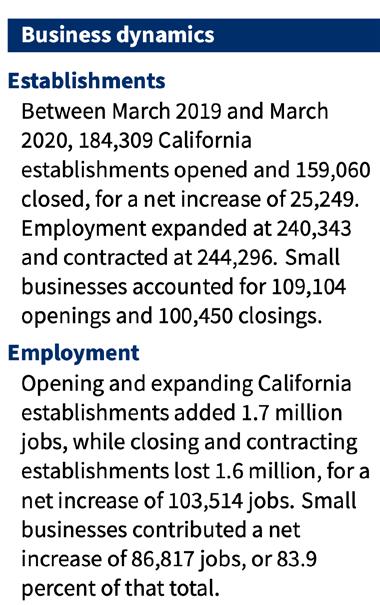
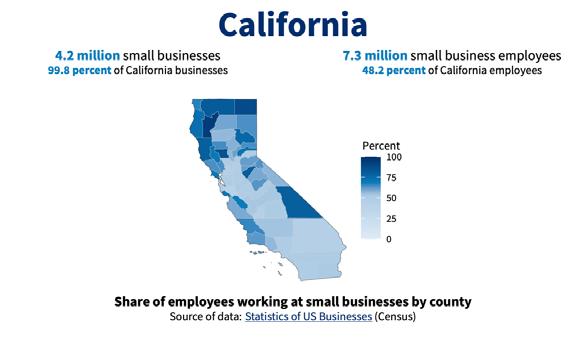
• Of the 860 total loans made in 2020, 690 were microloans representing $10.9 million (over 45% of all enrolled loans).
• The 2020 CalCAP annual report is available through this link (https:// bit.ly/3VyjLzg).
Borrower Demographics:
• Just over 50% of borrowers self identified as a minority-owned businesses, including 18.9% Hispanic, 18.9% Asian/Pacific Islander, 6.6% Black, and 5.2% Other.
• 31.3% of the borrowers selfidentified as female-owned businesses (17.3%) or jointly ownedbusinesses (14%) and with 68% of the borrowers self identified as maleowned businesses.
Excerpted from the State Assembly website: ajed. assembly.ca.gov/reports
JANUARY 2023 CALIFORNIA BROKER | 45 CalBrokerMag.com

46 | CALIFORNIA BROKER JANUARY 2023 CalBrokerMag.com For For 4 REASONS TO BE LISTED • BE INCLUDED: Enable brokers and colleagues to reach you • GET LEADS: Enable consumers to find you • BE RECOGNIZED: Show clients you are included in CalBroker’s eDirectory • COLLABORATE: Reach broker colleagues to help solve client problems eDIRECTORY CIRCULATION • Available on demand for print • Emailed weekly to 6,000 life and health brokers • Available on our website with 10,000 visits monthly • Consumers looking online for life and health insurance benefits professionals LISTING OPTIONS • Basic Listing includes logo and contact information with online hot link • Enhanced Listing is 1/8 Page Full Color Advertisement along with a Basic listing • Custom: advertisement up to a full page and a Basic listing Why Be Listed In the 2023 California Broker eDirectory CALIFORNIA BROKER ANNUAL INSURANCE RESOURCE CALIFORNIA’S LIFE + HEALTH PROFESSIONALS CONTACT: DIRECTORY@ CALBROKERMAG.COM




The average beneficiary has 43 plans to choose from and they need your help. Increase your leads, close more sales, and elevate your income by partnering with a trusted agency that provides the support you need! By 2030, there will be around 80 million people eligible for Medicare. Join us in our next session to learn about: • AGA’s Co-op & Marketing Dollar Programs – Earn an extra $169 for marketing per sale* • Tools & technology to build your lead and client base • Unlimited training to become a top-selling agent • Leads, events, and marketing programs available to you at discounted rates • Access to unparalleled service and support from a multilanguage team Scan to register for an upcoming session! 1-844-SALES-UP That’s over $24 BILLION in commission up for grabs!


48 | CALIFORNIA BROKER JANUARY 2023 CalBrokerMag.com Experience Word & Brown | wordandbrown.com Northern California 800.255.9673 | Inland Empire 877.225.0988 | Los Angeles 800.560.5614 | Orange
| San Diego 800.397.3381
effect Elements [Passion. Authenticity. Collaboration. Trust.]
800.869.6989
[&]
The [&] Effect is when two organizations develop a meaningful, One Team partnership, based on a unique set of elements that together generate a mutually beneficial outcome. It’s a phenomenon difficult to describe and only experienced when Word & Brown is by your side.



































































































































 BY TOM AVERY
BY TOM AVERY










 BY WAYNE GUZMAN
BY WAYNE GUZMAN































